Reserve Bank Bulletin – November 1998 Semi-Annual Statement on Monetary Policy
Download the complete Statement 386KB
The events of the past six months have been dominated by news of financial instability, while changes in the underlying world economy have unfolded at a much more gradual pace. The financial market turmoil that began in Thailand in mid 1997 has now circled the globe and encompassed markets in major industrial countries, most notably the United States. At the time of the Bank's previous Semi-Annual Statement, the turmoil had spread from Thailand to the whole south-east Asian region. Since then, it has moved through three further phases: in June, it affected Japan, causing a sharp weakening of the yen and a fall in the share market; by August, the effect had spread to Russia, which eventually devalued its currency and announced a moratorium on repayment of government debt; and by September, it had an impact on the US and European banking systems.
The defining characteristic of markets recently has been an abrupt change of attitude towards risk taking. After a number of years in which a high appetite for risk on the part of international banks and borrowers had led to a large increase in leveraged cross-border flows of capital, circumstances changed sharply in mid 1998. An important part of the mechanism by which this change fed back to markets in industrial countries was the activities of hedge funds, which had borrowed heavily from banks in industrial countries to invest in emerging market assets. The collapse of emerging market asset prices following the actions of the Russian authorities left hedge funds nursing large losses, which in turn exposed banks that had provided funding to them through both equity and debt. In addition, banks, and especially investment banks, had large positions on their own account in emerging markets on which losses were incurred.
Asian financial markets, which had been subject to exceptional volatility over the preceding year, came through the latest episode unscathed, reflecting the fact that most of the ‘hot’ money had already exited these countries. In fact, the fall in the US dollar and the easing of US interest rates caused exchange rates in the region to strengthen and allowed the downward movement in interest rates, which had begun there in the June quarter, to proceed more quickly. In all these countries, apart from Indonesia, short-term interest rates are either at or below pre-crisis levels. This bodes well for economic conditions in the countries which were hardest hit by the crisis, some of which appear to be seeing some stabilisation now in economic activity. Their recovery is, nonetheless, likely to be gradual.
Elsewhere in the world, the underlying economic environment has changed little. Japan remains in recession, though with some hopeful signs that policy action may begin to assist in setting the scene for a recovery. Europe continues to expand, but with large disparities in economic performance among countries. The biggest change, however, is the emergence of question marks over the outlook for the US economy, arising from the possibility that the sudden risk aversion evident internationally might extend to domestic US financial activity, amplifying forces already at work to produce a slowing in US growth. It is by no means clear that such an outcome will eventuate, not least because the Federal Reserve responded pre-emptively to the possibility by easing monetary policy on two occasions. But it has to be acknowledged that uncertainty about the US, and therefore the global, outlook has recently been greater than for some years.
Australian financial markets in the past six months have continued to be affected by global developments. This was most evident in the exchange rate, with the Australian dollar coming under a couple of bouts of intense speculative selling pressure which drove it to new lows against the US dollar. Several countries experiencing similar pressures raised interest rates sharply in response. In Australia's case, the Bank judged that, on this occasion, the most appropriate way for it to deal with the exchange rate pressures was by intervention in the foreign exchange market, since the selling pressures reflected speculative activity rather than any loss of confidence in policy settings in Australia. The Bank undertook two main rounds of intervention, in May/June and August/September. Overall, the Australian financial system has so far come through the global turmoil without serious mishap.
The Australian economy has also weathered the first year and a half of a very difficult international environment exceptionally well, despite a quite substantial loss of export sales to Asia. On the most recent data, real GDP growth was running at a pace of around 4 per cent in late 1997 and through the first half of 1998. Growth is now likely to be noticeably lower than that, though indications confirming this are rather fewer than might have been expected thus far. Business confidence has fallen a little, but there are few signs at present of any abrupt and widespread scaling back of actual or planned activities. Certain sectors of the economy – notably manufacturing and mining – are finding conditions quite tough, but other areas continue to expand. At the same time, inflation has remained low, and over the most recent 12 months has been below the Bank's medium-term target.
These favourable outcomes owe something to the economy's own capacity to adjust to changed circumstances, including the success of exporters in finding new markets. But macroeconomic policy has also made an important contribution to the favourable outcome. The task for monetary policy has been to try to minimise the damage to the economy from the Asian crisis, and to ensure that the medium-term inflation target is achieved. It was always recognised that the first of these would involve some decline in the exchange rate. At the same time, it is well known that such periods of adjustment can often be traumatic, engendering financial and economic uncertainty, because it is in the nature of markets that financial prices are liable to overshoot. Instability in the exchange rate can itself damage confidence and disrupt business planning. An overly large decline in the exchange rate, if persistent, can also increase the risk of a rapid increase in inflation.
Despite these risks, this period of adjustment has to date occurred with comparatively little disruption to the domestic economy and financial conditions. Steadiness in monetary policy settings has contributed to this. Policy has had room to adopt this approach in this episode, unlike other episodes in Australia's history, mainly because of the success in maintaining low inflation and reasonable growth over recent years and the continued confidence of markets in the framework for macroeconomic policies generally.
The coming year looks as though it will be no less challenging for the Australian economy, and for monetary policy. With developments in the world economy again likely to be influenced by sharp changes or reversals in financial markets, the outlook can change over quite short periods. Even interpretations of the US outlook, which will be so important to Australia's growth next year, are subject to quite frequent revisions. Notwithstanding these uncertainties, it is hard to see circumstances in which growth in Australia will not decline somewhat from the good outcomes achieved in 1997 and the first half of 1998. At this stage, and given current exchange rates, the Bank still anticipates some further gradual rise in the annual rate of inflation as higher prices for imported products are gradually passed through. It appears unlikely, however, that the inflation target will be exceeded, given that domestic cost increases remain quiescent.
Monetary policy is seeking to steer a relatively steady path through these frequent changes in outlook and market sentiment. In evaluating current settings, the Bank takes into account not only the level of official interest rates, but also those faced by borrowers (which have declined over the past year), the level of the exchange rate, which is assisting exporters, and the state of asset and credit markets. This combination seems to have been broadly appropriate for the economy's evolving conjuncture, but as usual, policy settings will remain under continual review in light of changing international and domestic circumstances.
Financial Markets
The evolving world financial crisis
The first signs that the financial turmoil was spreading beyond the emerging Asian markets came in the June quarter when markets in Japan came under pressure. The channels through which this contagion occurred were partly financial, since Asian economies had been the destination of much Japanese investment, but also included economic links. Asian countries had been very important export markets for Japanese firms and the rapid weakening in their economies exacerbated the recessionary conditions in Japan. The subsequent loss of confidence in Japanese policy-making saw the yen and the share market weaken sharply, and Japanese long bond yields fell below 1 per cent (Graph 1). As well as the weakening economy, the fall in the yen reflected extraordinarily low Japanese interest rates that gave rise to the so-called ‘yen-carry’ trade, which involved borrowing yen and converting the proceeds into higher yielding assets in other currencies. Large speculative positions were built up in this way by international banks and hedge funds.
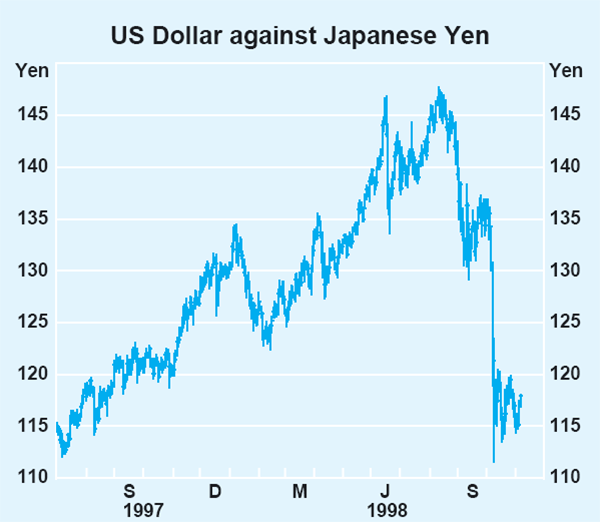
As the yen weakened, it put pressure on the competitiveness of Asian countries and raised fears of further devaluations in the region including, importantly, China and Hong Kong. As noted below, the Australian dollar also became caught up in this.
It was against this background that the US Fed intervened to support the yen in mid June, causing it to strengthen from 147 to 134. This took pressure off other currencies for a time, including the Australian dollar and, by July, international markets had become quite settled.
The calm was again disturbed in August when Russia devalued and announced a moratorium on foreign debt repayments. There had been signs of increasing problems in Russia since late May, but investors drew comfort from the assumption that, since Russia was on an IMF program it would not devalue, let alone default. In the event, this confidence was misplaced. The rouble lost three-quarters of its value against the US dollar, short-term interest rates rose, at the worst of the crisis to about 160 per cent, and share prices fell heavily. Major Russian financial institutions collapsed as the crisis deepened.
The debt moratorium and rouble devaluation caused heavy losses to banks and hedge funds. Moreover, because the move also made investors suspicious of other emerging markets, credit spreads widened elsewhere, particularly in Latin America. Up until then, countries in Latin America had been only tangentially affected by the global turmoil, but threads common to crises elsewhere rapidly appeared in August: intense downward pressure on currencies, sharp rises in interest rates, and heavy falls in equity markets, with share prices in the region down by an average of 35 per cent from late July to early September.
Brazil was the main focus. With the economic fundamentals – especially the budgetary position – viewed as weaker than in other large Latin American economies, it was subject to strong exchange rate pressures, despite a rise in short-term interest rates to around 40 per cent. Since mid 1998, Brazil's foreign reserves have halved, to US$40 billion. One concern was that if the real were devalued, other Latin American countries, which had been successfully pursuing orthodox macroeconomic policies, might also be knocked off course by contagion effects of the sort evident in Asia in 1997. To prevent this, the IMF, with strong US support, is negotiating a package of support for Brazil.
Asian markets seemed generally detached from this phase of the crisis, with the exception of Hong Kong where hedge funds took aggressive short positions in August, both in the foreign exchange and equity markets. The move aimed to profit either from a fall in the exchange rate or, more likely, a weakening in the share market as interest rates rose in response to exchange rate pressures. The Hong Kong Monetary Authority responded by intervening in both the foreign exchange market and the equity market to prevent speculative profits being realised. This approach was successful in pushing share prices higher, and causing speculators to retreat. It received support from the US monetary easings and the fall in the US dollar.
By late August, stories were starting to circulate in markets about heavy losses sustained by hedge funds and investment banks as a result of their emerging market activities. A number of firms went public on their financial position, in an attempt to calm investors and bank creditors, but with financial prices still moving against them these early statements of losses proved conservative. By early September, Long-Term Capital Management (LTCM), a hedge fund run by people that many regarded as the best and brightest of the US financial industry, announced that it had lost virtually all its capital. The extent of its positions were so large that the US Fed concluded that its failure would have systemic implications and it co-ordinated a rescue package involving some of the world's most prominent banks, which had been heavy lenders to LTCM (among other hedge funds).
As the situation unwound, there was a sharp fall in the US dollar, averaging 10 per cent in trade-weighted terms, but including a fall of 20 per cent against the Japanese yen. This weakening reflected partly the changed outlook for the US economy and monetary policy, but the move against the yen was also driven by the unwinding of short-yen positions by hedge funds after their credit lines had been cut back. Most of the fall in the US dollar/yen exchange rate took place over two days – 7 and 8 October – in what was the biggest exchange rate change for a major currency pair in such a short period since the move to floating exchange rates in 1973. It took the exchange rate back to its level in mid 1997, before the outbreak of the Asian market crisis, with generally beneficial effects for Asia.
At the same time as the dollar fell, signs of stress rapidly appeared in the US financial system, and also in European markets. These took three main forms:
-
Falls in bank share prices. In broad terms, prices of bank shares in the US and Europe halved between mid July and early October (Graph 2). This was an important factor dragging down share prices more generally, with the overall US share market losing 20 per cent and European markets falling by about 40 per cent. The calming influence of the US monetary easings (see below) has seen about two-thirds of these losses subsequently reversed.
Graph 2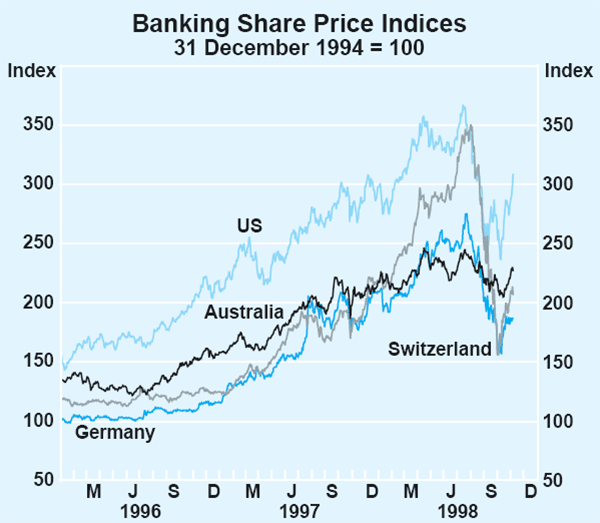
-
A flight into government bonds issued by highly rated countries. It was notable that, even within government bond markets, investors sought to buy only very liquid lines of stock, such as short maturities or ‘on-the-run’ series. US 10-year bond yields fell from 5.5 per cent in July to under 4.2 per cent in early October (Graph 3). Expectations of capital gains from an easing of monetary policy added to the buying pressure.
Graph 3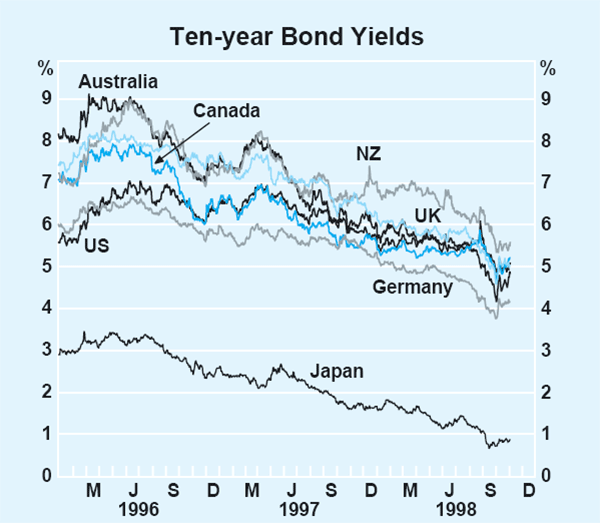
-
A widening in credit spreads across the risk spectrum, especially at the riskiest end (Graph 4). Some sectors of capital markets effectively ceased to operate for a time. Markets for low-grade investments were hardest hit. Spreads on emerging market debt rose to almost 15 percentage points above US Treasury yields. But even within US markets, spreads for riskier credits widened sharply: spreads on low-grade corporate bonds widened to about 7 percentage points over Treasuries (twice the normal margin); while spreads on bank debt increased to 1 percentage point (again roughly twice normal levels).
Graph 4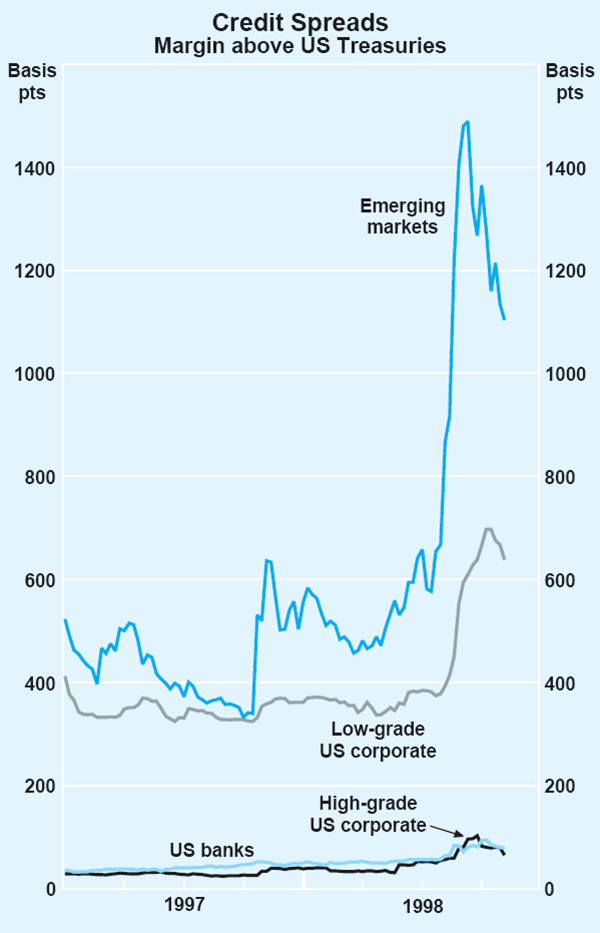
The US Federal Reserve reacted to the disruption in US markets, particularly signs that the flow of credit through markets was being curtailed, by easing monetary policy on two occasions. This reflected a sharp turnaround from the Fed's earlier bias (held as recently as July) to tighten. The first of these easings took place at the Federal Open Market Committee Meeting in late September; the second was an inter-meeting move two weeks later (the first inter-meeting change in monetary policy since April 1994). In total, the Federal funds rate was reduced by 0.5 percentage points, to 5 per cent. A number of other countries have also eased in the past month or two. With the exception of Japan and some countries in Europe, all the countries that have eased recently had earlier tightened some time between early 1997 and mid 1998, either because of excessive demand pressures or because of downward pressure on exchange rates (Box A).
It is, of course, too early to tell whether these policy adjustments will be successful in their broad objectives of stabilising economic activity, but there has clearly been a noticeable calming in markets around the world since they were implemented. Credit spreads in the US and on emerging market debt have come off their peaks, although they remain well above longer-run norms; issues of corporate debt have resumed, after coming to a standstill in early October; and share prices have risen strongly. In short, at this stage markets are showing confidence that the Fed may have acted sufficiently quickly to prevent the pronounced slowing in US economic activity that some had earlier feared.
Nonetheless, the risk-taking that characterised the bull market of recent years, which was associated with very low risk premiums, is unlikely to return for some time. Greater wariness about credit quality following the problems incurred by hedge funds and other Wall Street firms means that the boom in financial market activity of the past five years will be curtailed as banks become more cautious, at least for a time, while rebuilding balance sheets.
Closer to home, financial markets in the Asian region have recently taken a noticeable turn for the better. Signs of improving market confidence had been evident for some months but the US monetary easings gave this a decided lift. Exchange rates, which at their trough in January this year were down about 50 per cent against the US dollar from mid 1997 levels, have recovered to be down around 30 per cent. Even the Indonesian rupiah has risen strongly, from 15,000 to the US dollar as recently as July to about 8,500 (still, of course, down by around 70 per cent from its pre-crisis levels). Interest rates in most countries have fallen to pre-crisis levels and, in the case of South Korea and Thailand, well below. The exception is Indonesia where interest rates remain very high, although off their peaks. Share markets across the region have risen on average by about 30 per cent since end September, though they are still on average down about 40 per cent from mid 1997 levels.
| Exchange rates | Share markets | Level of short-term interest rates |
||||||||||
|---|---|---|---|---|---|---|---|---|---|---|---|---|
| Percentage change from date shown | Per cent | |||||||||||
| 2 Jul 97 | 1 Jan 98 | 1 Oct 98 | 2 Jul 97 | 1 Jan 98 | 1 Oct 98 | 1 Jan 97 | 2 Jul 97 | 1 Jan 98 | Latest | |||
| Asia | ||||||||||||
| Thailand | −22 | 29 | 9 | −36 | −3 | 42 | 13 | 22 | 26 | 9 | ||
| Indonesia | −71 | −36 | 28 | −51 | −12 | 30 | 13 | 13 | 29 | 59 | ||
| Philippines | −34 | −1 | 11 | −36 | −6 | 44 | 12 | 12 | 31 | 15 | ||
| Malaysia | −34 | 2 | 0 | −60 | −26 | 19 | 7 | 7 | 9 | 7 | ||
| Hong Kong | 0 | 0 | 0 | −33 | −5 | 30 | 6 | 6 | 9 | 6 | ||
| Taiwan | −14 | 1 | 6 | −23 | −15 | 4 | 6 | 7 | 8 | 6 | ||
| Singapore | −12 | 4 | 5 | −34 | −15 | 42 | 3 | 4 | 6 | 2 | ||
| Korea | −33 | 29 | 6 | −46 | 11 | 37 | 13 | 12 | 25 | 8 | ||
| Other emerging markets | ||||||||||||
| Russia | −62 | −61 | 5 | −87 | −85 | 47 | 15 | 10 | 31 | 33 | ||
| Argentina | 0 | 0 | 0 | −40 | −28 | 41 | – | 7 | 12 | 13 | ||
| Brazil | −10 | −6 | −1 | −40 | −21 | 36 | – | – | 38 | 42 | ||
| Chile | −10 | −5 | 1 | −35 | −22 | 22 | 7 | 7 | 7 | 9 | ||
| Colombia | −30 | −17 | −1 | −45 | −51 | −5 | 24 | 22 | 23 | 35 | ||
| Mexico | −20 | −19 | 3 | −6 | −18 | 26 | 25 | 20 | 19 | 32 | ||
| Venezuela | −14 | −11 | 1 | −58 | −55 | 7 | 4 | 5 | 10 | 5 | ||
The impact on Australian financial markets
The Australian dollar
The global turbulence was reflected in Australian markets mainly through the exchange rate. In 1998, there have been three main episodes of pressure on the currency. The first – in January – was associated with problems in the emerging markets of Asia, and was discussed in the previous Semi-Annual Statement. The two subsequent bouts of pressure – in May/June and August/September this year – flowed respectively from events in Japan and Russia (Graph 5).
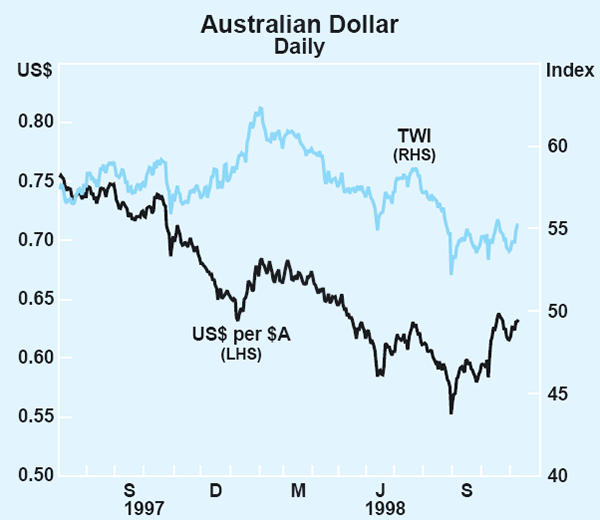
Over the second half of 1997, the Australian dollar had developed quite a close relationship with the yen, and by early 1998, it had become commonplace in markets to talk about the Australian dollar being part of the ‘yen-bloc’ (Graph 6). With the yen beginning to weaken more noticeably in the June quarter, as the economic outlook for Japan deteriorated and speculators became confident in shorting the yen, the Australian dollar began to fall more quickly as well.
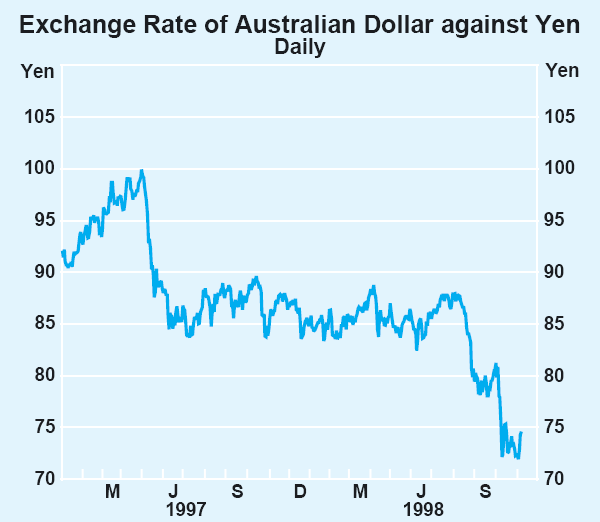
The Bank never subscribed to this ‘yen-bloc’ view of the Australian dollar, as the model underlying it seemed to be flawed to the extent that the economic performance of the two economies was very different despite the strong trade links, making it difficult for the close relationship of the currencies to persist in the longer term. Nonetheless, the Bank did not seek to prevent the fall in the Australian dollar from February through April as the yen weakened.
In mid May, however, the Bank intervened – in a low-key way – in the foreign exchange market, to ensure settled conditions around the time of the Budget. Then, in late May and early June, the Bank returned to support the exchange rate when aggressive tactics by hedge funds, both in the size of their short positions and their market behaviour, caused the exchange rate to start to fall sharply, even against the weakening yen.
The Bank intervened as the exchange rate fell towards US60 cents, buying a total of $2.6 billion in Australian dollars. This brought the total intervention during the May/June period to $3.2 billion. The size of the intervention reflected the scale of the speculative bets put in place against the Australian dollar at this time. However, the selling pressure was such that the Bank's purchases were sufficient, initially, only to slow the fall in the exchange rate, which eventually reached US58.2 cents. One consequence of the Bank's intervention, however, was that speculators were left with substantially larger short positions, at a less profitable exchange rate, than they generally expected. As events unfolded, this set the stage for the Australian dollar's later rise, as substantial short covering of the Australian dollar also took place when the joint intervention was undertaken by US and Japanese authorities to strengthen the yen. By July, the Australian dollar had regained US63 cents, where it had been in May before the attack.
The period of calm proved brief. The outbreak of the Russian crisis in August, which was judged by markets to have potential negative implications for commodity prices due to possible dumping by Russia, again caused the exchange rate to weaken. Further, the Australian dollar was used by hedge funds and other speculators as a vehicle to hedge exposures in other, less liquid, markets where they had been caught. The exchange rate moved down to around US55 cents. On this occasion, the vulnerability of the Australian dollar was highlighted by the fact that the Bank of Canada raised interest rates to support the Canadian dollar, often seen as a close substitute for the Australian dollar. The Bank did not raise interest rates, but again bought Australian dollars over late August/ early September – $0.7 billion in total – a process which, on this occasion, moved the exchange rate noticeably higher.
The exchange rate steadied during September at a little under US60 cents but then rose sharply in October when hedge funds scrambled to cover positions following losses sustained as the yen rose sharply against the US dollar. The rise in early October of about US6 cents over eight days was the largest appreciation in a similar period since the Australian dollar was floated in December 1983. The reduction in US interest rates, to a level on a par with Australian rates, also helped by closing the differential that had previously favoured the US dollar.
| May | 575 |
|---|---|
| June | 2,630 |
| Late August/early September | 665 |
The exchange rate had settled around US63 cents by early November, up by 14 per cent from its low in late August. Over the same period, it weakened against the surging yen (by 7 per cent), which limited the rise in the exchange rate in trade-weighted terms to around 4 per cent. The trade-weighted index remained 5 per cent below its level in early May, and around 10 per cent below its level in early 1997.
Interest rates in Australia
The cash (policy) rate target has remained at 5 per cent, where it has been since mid 1997. Market yields in Australia, however, have fluctuated in response to the changing pressures on the exchange rate, and with the moves in US monetary policy. Until late in May, short-term market yields were a little lower than the cash rate as investors continued to price in the possibility that the five easings between mid 1996 and mid 1997 would be followed by a sixth. These expectations were revised abruptly, however, as the exchange rate fell in early June (Graph 7). A similar pattern of short-term interest rates was evident in late August and early September as the exchange rate again fell heavily. In both episodes, the yield on 90-day bills moved well above 5.5 per cent, reflecting strong expectations that monetary policy would be tightened to steady the exchange rate. This was quickly reversed as talk of the possibility of a US easing emerged and the Australian dollar appreciated. The yield on 90-day bank bills fell to below 5 per cent by the time of the first easing in US monetary policy at end September. It fell further when the Fed eased a second time, and subsequently remained below the cash rate, indicating some expectation of an easing, though not necessarily in the immediate future.

The bout of exchange rate pressure in early June also saw bond yields rise from their then cyclical low, of about 5.35 per cent, to 5.8 per cent. The rise in yields at the time of the exchange rate weakness late in August was larger, with the yield on 10-year bonds rising above 6 per cent, but this proved very brief as the wide differential relative to US bonds quickly attracted buyers. Since then, the continued drop in bond yields globally, the recovery in the Australian dollar, and the buoyancy in short-term interest rates have seen bond yields in Australia rally to new lows (Graph 8). The yield on 10-year bonds fell to about 4.85 per cent in mid October, their lowest level since February 1965, before settling a little above 5 per cent.
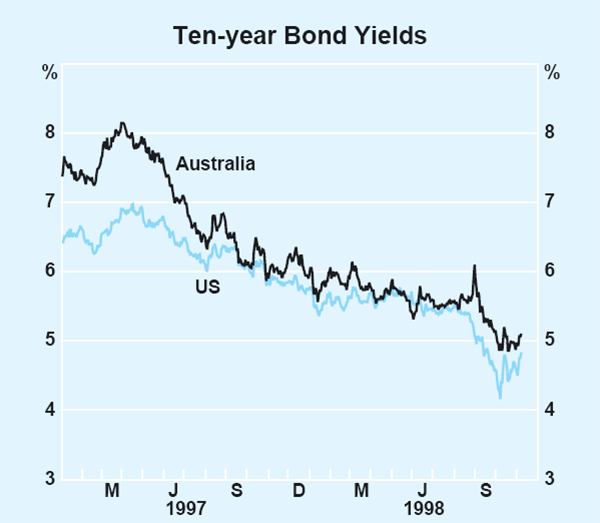
Australian interest relativities to the US have changed significantly over the past six months. At the short end, the easings by the Fed have resulted in the US policy rate moving into line with that in Australia; Australian short-term rates had been 50 basis points below those in the United States since July 1997. At the long end, bond yields in Australia moved down by more than those in other major countries early in 1998, to a level below US rates by May. As the exchange rate then weakened, local bond yields moved back above US rates, reaching a differential of about 100 basis points late in August. Subsequently, this differential has narrowed to about 30 basis points.
There is some evidence of widening margins within Australia on lesser quality credits. New issues of corporate debt have also declined. But these developments are on a more modest scale than in US debt markets, partly reflecting the fact that securities markets represent a much more limited source of funds for Australian corporates. While Australian banks are reported to have cut back on interbank exposures to foreign (particularly US) banks, lending to Australian companies and households remains healthy (see chapter on ‘Financial Conditions’ below). There is no sign of a credit crunch developing in Australia.
Box A: Changes in Short-term Interest Rates in Industrial Countries
From early 1997 until recently, there had been a widespread tendency among industrial countries, albeit a gradual one in some cases, towards higher policy interest rates. In some countries, this was aimed at restraining incipient inflationary pressures arising from strong demand, and in others it reflected attempts to limit falls in exchange rates. Leaving aside Japan, where short-term interest rates were at the extremely low level of 0.50 per cent until September 1998, and then cut further to 0.25 per cent, the countries fall into three groups:
- the English-speaking countries (United States, United Kingdom, Canada, New Zealand and Australia);
- the Euro 11 – i.e. the eleven countries that will adopt the Euro on 1 January 1999 (Germany, France, Italy, Spain, Netherlands, Belgium, Austria, Finland, Portugal, Ireland and Luxembourg); and
- the Scandinavian countries (Sweden, Norway and Denmark).
English-speaking countries
All English-speaking countries, including Australia, had eased monetary policy during 1996 against a background of below-average growth and low inflationary pressures. But by the first half of 1997 all had started to raise interest rates, except Australia, where two further cuts in interest rates were made in May and July 1997 (see Graph).
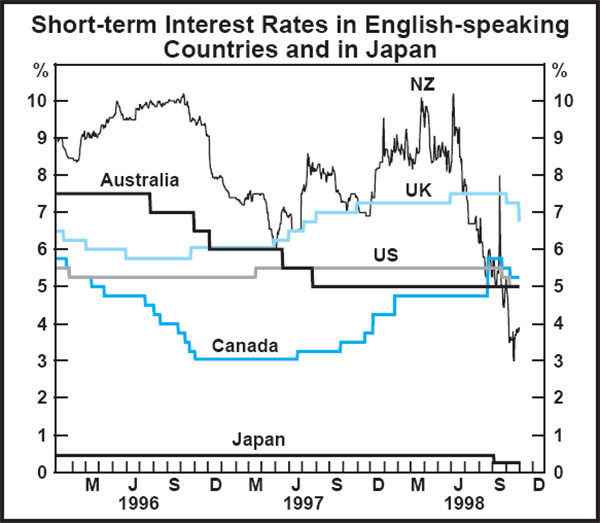
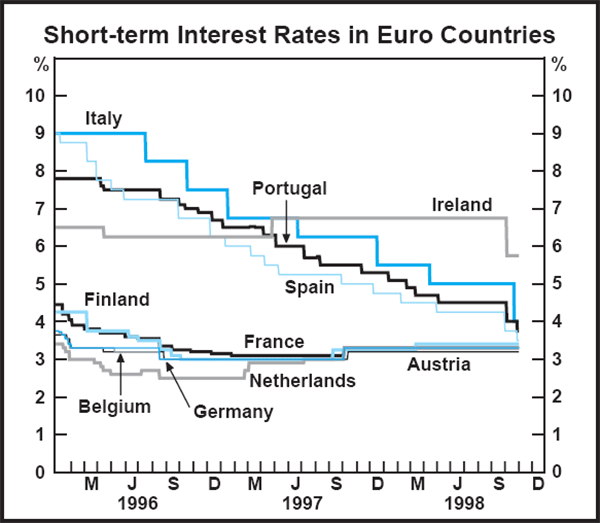
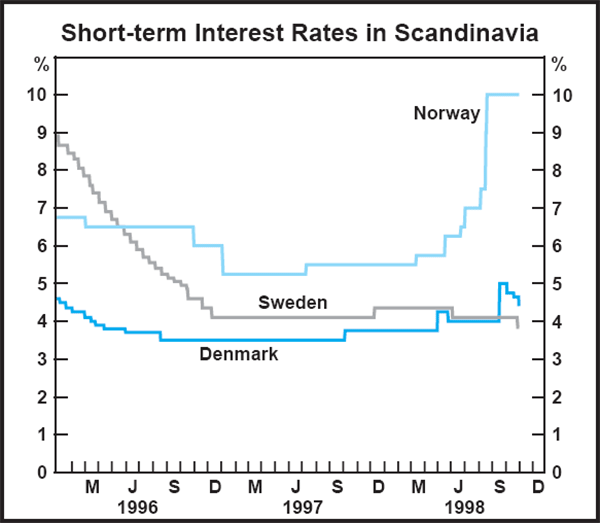
The US Fed increased interest rates only once – in March 1997, from 5.25 per cent to 5.50 per cent – but it retained a bias towards tightening at most Federal Open Market Committee meetings through to July 1998. Canadian interest rates rose in five steps between mid 1997 and early 1998, from 3.0 per cent to 4.75 per cent, and then to 5.75 per cent in August as the Canadian dollar came under pressure. The UK tightened on six occasions between late 1996 and the end of 1997, lifting rates from 5.75 per cent to 7.25 per cent. Amid signs that inflationary and wage pressures might have been stronger than earlier thought, the Bank of England made a further tightening of 0.25 percentage points in June 1998.
While most of the increases described above reflected concerns about emerging inflationary pressures as economic activity picked up, the increases in New Zealand interest rates which began in the middle of 1997 were associated with a fall in the exchange rate of the New Zealand dollar. Like the Australian dollar, the New Zealand currency came under downward pressure from the middle of 1997 following the outbreak of the Asian crisis, and the increases in interest rates acted as a counterweight to prevent too rapid a fall in the Monetary Conditions Index – the exchange and interest rate composite used to guide monetary policy in New Zealand. Between mid 1997 and mid 1998, short-term interest rates in New Zealand rose from around 7 per cent to about 9 per cent.
The four countries which raised interest rates in 1997 and into 1998 have all reduced them recently. In New Zealand, where interest rates began to fall in late June 1998 as signs became clearer that the economy was in recession, short-term interest rates have since fallen to around 3.5 per cent. The US eased in late September and again in mid October, on each occasion by 0.25 percentage points, reducing the Fed funds rate to 5.0 per cent. These easings were in response to turmoil in US financial markets. Canada quickly followed the US on each occasion, effectively reversing half the August rise in rates. The UK eased in both early October and early November, by 0.25 percentage points and 0.50 percentage points respectively, to 6.75 per cent.
Euro countries
The decision by 11 European countries to adopt the Euro as the single currency at the start of 1999 means that their policy interest rates need to converge by that time. At the start of 1996, short-term rates in the 11 countries ranged from 3.40 per cent to 9.0 per cent. Through 1996, interest rates in all 11 countries fell (admittedly by different amounts) as, like the English-speaking countries, they responded to softer economic activity (see middle panel of Graph). In 1997, however, Germany, France, the Netherlands, Finland, Belgium, Ireland and Austria raised interest rates as economic activity in these countries picked up and inflationary pressures increased. More recently, those at the high end of the range have implemented cuts so that rates now range from 3.20 per cent to 5.75 per cent.
Through the first half of 1998, the expectation was that short-term rates in these countries would eventually converge at the weighted average – 3.75 per cent. But with inflationary pressures turning out to be less intense than earlier thought, expectations in recent months have swung to favour convergence towards the bottom end of the range.
Scandinavia
The path of official interest rates in the Scandinavian countries is shown in the bottom panel in the Graph. Like other industrial countries, they too eased through 1996 and then began to tighten in the second half of 1997. Sweden reversed its tightening in June 1998 – cutting rates by 0.25 percentage points to 4.10 per cent – as inflationary pressures turned out to be less than earlier expected. It eased further in early November, to 3.85 per cent.
Norway and Denmark, on the other hand, raised interest rates substantially further in 1998, mainly in response to exchange rate pressures. In the case of Norway, rates were raised from 5.50 per cent to 10 per cent, while in Denmark they rose from 3.75 per cent to 5.75 per cent. Since then, Denmark reversed some of this, cutting rates in three steps to 4.40 per cent, but Norway has left rates unchanged.
Box B: The Use of Leverage in Financial Markets
One of the revelations that emerged from the recent market turmoil was that the positions being carried by hedge funds, and the extent to which banks had funded them, were much bigger than most observers had appreciated. These firms were able to run large positions relative to their capital bases because markets have evolved ways of funding positions which are very economical in terms of capital requirements. This box outlines typical ways in which market participants can leverage themselves in financial markets.
Repo markets
In securities markets, positions are usually funded through repurchase agreements, or repos. These are a form of collaterised loan, on which the lender takes a margin or ‘haircut’ to protect itself against adverse movements in the price of the securities used as collateral. In government securities markets in most industrial countries, haircuts usually run at 2 per cent of the value of the loan, though they can vary with the maturity of the security. Thus, a hedge fund that had $2 billion in capital could, through repos, borrow enough to fund a holding of $100 billion of securities by applying the capital to haircuts – i.e. it could gear up 50 times.
The haircuts involved on repos in emerging market securities are larger than those on Treasury securities but still allow substantial gearing. Because these markets had performed well over a run of years, and their price volatility had declined, haircuts had been below levels which could absorb recent falls in values. Lenders reacted by calling in increased margins, and the de-leveraging that followed proved very disruptive to market conditions as positions were forcibly and quickly cut.
Derivative markets
Gearing can also be generated through derivatives markets since purchases or sales of derivative contracts do not require immediate payment of the full face value of the contracts; rather, only a margin needs to be paid. As initial margins are typically less than 2 per cent for bond contracts and less than 6 per cent for equity contracts, investors can take on exposure to market positions that are many multiples of their capital. With options, the extent of gearing that can be attained depends on the premia that investors need to pay, which vary with market conditions and the characteristics of the options. In most cases, however, the premium is only a small percentage of the face value of the option, so very high gearing can be attained.
Foreign exchange markets
In foreign exchange markets, the ability to acquire positions without having to commit capital is relatively unconstrained. This is because most deals tend to involve the exchange of one currency for another, rather than the exchange of cash for securities, and therefore haircuts are not taken.
There are two key elements involved in taking a speculative currency position: first acquiring the position; and second arranging the funding. Taking recent events in Australia as an example: hedge funds sold Australian dollars in June to establish short positions in order to profit from the expected fall in the currency. This was done by arranging deals with a bank to sell Australian dollars in exchange for US dollars for normal ‘spot’ settlement (i.e. within two business days). Because the hedge funds were establishing short positions, in the sense that they did not own a corresponding amount of Australian assets to start with, they needed to generate Australian dollars within two days to meet the deliveries to which they had committed.
The typical way in which such a short position would be covered is by entering into a foreign currency swap transaction. Under the first leg of the swap, which is timed to coincide with the settlement date of the spot transaction, the hedge fund would buy Australian dollars and sell US dollars – i.e. the reverse of the spot transaction – so as to effectively cancel out the flows of funds, as shown below. In the second leg of the swap, the hedge fund would provide Australian dollars and receive US dollars on an agreed future date.
| Day 1 | Sell Australian dollars for US dollars in the spot market (delivery due Day 3). |
|---|---|
| Day 2 | Undertake a currency swap, with first leg to involve the purchase of Australian dollars and sale of US dollars (delivery due Day 3), and the second leg the sale of Australian dollars and the purchase of US dollars at some future date. |
| Day 3 |
Undertake settlement: – receive Australian dollars from swap counterparty and deliver them to spot counterparty (net flow is zero). – receive US dollars from spot counterparty and deliver them to swap counterparty (net flow is zero). |
Through these transactions, a hedge fund is able to take a position in the currency market without needing to supply either Australian dollars or US dollars until some point in the future. Effectively, all it has is a forward commitment, which requires neither capital nor any immediate funding.
The cost of the swap to the hedge fund is the difference between Australian and US interest rates for the period of the swap. This is built into the exchange rates agreed for the second leg of the swap, so again there are no up-front payments.
Swaps can be undertaken for any term, but are mainly for short periods – out to one week. If the exchange rate has fallen before the maturity of the swap, the short-seller can buy Australian dollars in the spot market at a profit to deliver into swap commitments. If not, the position can be rolled forward for a further period (or, of course, closed out at a loss).
The only constraint on the size of the positions hedge funds can undertake through these transactions is the willingness of banks to provide forward foreign exchange facilities. This depends on the banks' assessment of the risks involved and on the amount of capital they need to allocate to support the facility in accord with prudential requirements. Banks only undertake the transactions with the counterparties for which they have established credit limits, which restricts the types of counterparties which can access large positions in this way. But hedge funds, with a history of high returns and a substantial market reputation had no trouble gaining access to large credit limits from banks, particularly as they generated so much income for banks through their trading activities. In fact, so strong was the standing of hedge funds that they often insisted that banks which wanted to deal with them also provide funding.
From the banks' side, there are constraints in the form of capital requirements imposed under the Basle capital adequacy rules. These, however, apply only to swap contracts for settlement in more than 14 days, and even these are very small. For example, the capital requirement on swaps with maturities between 14 days and one year amount to only 0.04 per cent of the value of the contract. In other words, a $A100 forward facility provided to a (non-bank) investor requires the bank to set aside 4 cents of capital.
International Economic Developments
United States
Prospects for global economic growth and stability depend even more heavily than usual on the United States. At the same time, uncertainty over the outlook for the US economy has increased over recent months.
This is not because of the slowing in US growth: evidence for this had been accumulating over the course of 1998 and recent developments were in line with expectations. Some slowdown was overdue because through both 1996 and 1997 US GDP had expanded at nearly 4 per cent per annum, whereas the US economy's potential growth rate is normally thought to be about 2 to 2½ per cent. Even though this had been accompanied by a better inflation performance than might have been expected on the basis of historical relationships, a slowdown in growth has been seen as desirable, in order to prevent, at some stage, an increase in US inflation, with then a heightened risk of recession. The only real question had been whether a tightening of US monetary policy would be required to bring such a slowing about. As was noted above, as recently as July, the Federal Reserve had signalled that it was close to such a tightening.
Such a step proved unnecessary as evidence of the US economy's deceleration became clearer. Although the third quarter national accounts recorded a stronger GDP increase than expected, at 3.4 per cent over the year, there are a number of signs that growth is easing (Graph 9). US exports, which had grown at around 10 per cent over 1997, have declined during 1998. This is partly as a result of weaker world markets but also due to the high value of the US dollar; import penetration into the US economy has increased for the same reason. These effects have had a noticeable impact on the manufacturing sector, where output growth has fallen sharply and employment stopped growing. It remains true that other parts of the US economy show strength: service-related industries are continuing to expand at a strong pace, and employment gains continue; and housing starts rose to their highest level in over 10 years in the September quarter, helped by low interest rates. But overall, there are reasonably clear signs that the strong growth of recent years is now giving way to a more moderate pace of expansion.
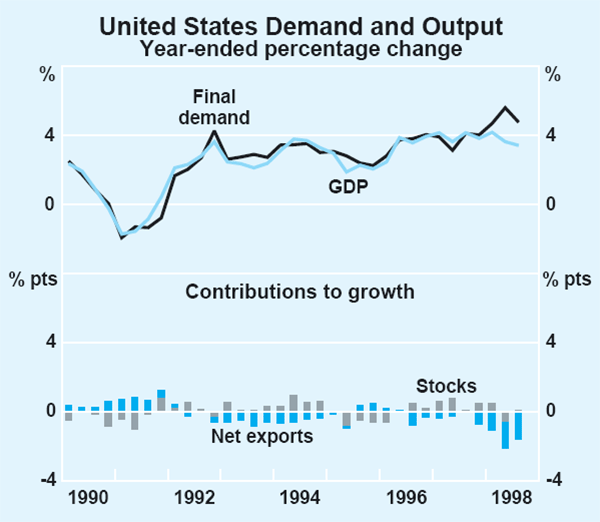
As noted above, some slowing was anticipated, and desired, by US policy-makers. What concerned them during September and October was the possibility that with these forces already in operation to dampen growth, a sudden desire to shed credit risk by lenders, amid a general atmosphere of financial market panic, would increase the risk of an unnecessarily sharp slowing. The events described in the chapter on ‘Financial Markets’ above saw, for the first time, questions raised about the strength of some large US financial institutions. It was this, rather than the possible trade linkages to emerging markets (which are not as important to the major countries as financial linkages) which appeared to prompt the two pre-emptive easings of monetary policy by the Federal Reserve in September and October.
There has subsequently been much discussion of a possible ‘credit crunch’. That term is usually taken to mean not just a rise in the price of credit to risky borrowers, but a serious lack of availability of credit at virtually any price even to large numbers of credit-worthy borrowers, driven by lenders' desire to protect their own balance sheets. While there has been some increase in the cost of credit to domestic borrowers, as described in the chapter on ‘Financial Markets’ above, the recent events in the US could not be described in those terms, nor is it clear that such an outcome is in prospect. Even so, the outlook for the US economy is more uncertain than it has been for some years. In the period immediately ahead, continuing employment growth, albeit below the pace seen earlier in the year, and the decline in the cost of personal finance stemming from the low level of US bond yields, should help to sustain consumption growth. On the other hand, with share prices having performed strongly over recent years, US households' spending has grown faster than income, savings rates have declined to very low levels and debt burdens increased. That conjuncture could mean that consumer demand might be prone to retrenchment were there to be significant further declines in financial wealth.
Europe
The expansion in Europe is continuing, though it remains quite uneven. The French economy has been growing strongly, led by the expansion in investment and consumption. German growth has been less consistent, with weak consumer demand; business confidence has declined in Germany in recent months. In the United Kingdom, activity is slowing from above-trend growth rates. Several smaller countries are recording much higher rates of growth, but are nonetheless reducing interest rates in the run-up to the commencement of European Monetary Union on 1 January next year. Overall, the monetary stance of Europe is quite accommodative, and is becoming more so.
The exposure of European financial institutions to emerging markets is quite substantial (Table 3), though this has not, so far, been the subject of discussion in Europe to the same extent as in the United States.
| Initial crisis economies(a) |
China and Taiwan |
Russia | Other eastern Europe |
Latin America |
Total | ||
|---|---|---|---|---|---|---|---|
| United States | 22.0 | 4.7 | 7.1 | 3.5 | 63.4 | 100.6 | |
| Japan | 86.7 | 23.1 | 1.0 | 3.2 | 14.7 | 128.6 | |
| Europe | 98.6 | 48.2 | 49.6 | 38.5 | 156.7 | 391.7 | |
| of which: | |||||||
| – Germany | 32.0 | 10.6 | 30.5 | 19.6 | 36.6 | 129.3 | |
| – France | 25.7 | 13.7 | 7.0 | 3.5 | 25.0 | 74.9 | |
| – Italy | 1.6 | 2.0 | 4.3 | 1.3 | 12.2 | 21.4 | |
| – United Kingdom | 17.4 | 11.2 | 1.0 | 1.9 | 21.5 | 52.9 | |
| Total | 207.2 | 76.0 | 57.7 | 45.2 | 234.7 | 620.9 | |
|
(a) South Korea and the ASEAN-4. Source: BIS |
|||||||
Japan
The Japanese economy remains extremely weak (Graph 10). Output has been contracting since the middle of 1997, and the latest national accounts data (for the June quarter) showed declines in almost every major category of expenditure. Employment has weakened and unemployment has risen to levels previously unknown in modern Japan. With falling incomes, and prices continuing to decline, households have not been inclined to expand consumption expenditure, despite the income tax cuts. Private investment expenditure also continues to decline, a response to rising excess capacity, and the declining availability of credit.
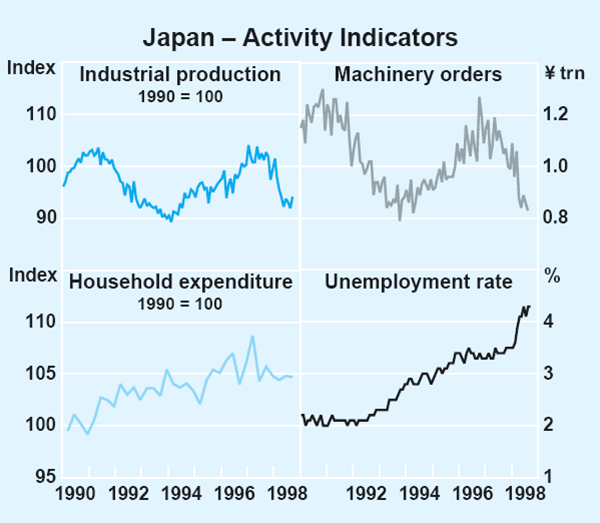
Japanese policy-makers face an extraordinarily difficult task in turning the situation around. Their approach has three major parts. The first is the maintenance of extremely low interest rates. The Bank of Japan's overnight rate was further reduced in September to 0.25 per cent. The second element is an expansion in public spending. An amount equivalent to around 2 per cent of GDP is scheduled to be spent on public works in the second half of this year – income tax cuts equivalent to 1 per cent of GDP are also scheduled – and there are now early signs of this spending having an impact in the construction sector. The government is also considering further spending initiatives and further income tax cuts. There has been a number of such packages over the 1990s. They have usually been effective in adding to growth while they were in operation, but in recent years the private sector of the Japanese economy has not gained sufficient momentum to cope with the loss of fiscal stimulus once the packages were completed.
One reason for that has been the state of the Japanese banking system, which has been a serious constraint on the economy for some time. Credit outstanding has declined over the past year, as banks have sought to combat serious problems of asset quality by restraining new loans (though some of the decline in outstandings is due to write-downs of bad loans). This process constrains borrowers, and dampens economic activity, which in turn risks a further worsening of banks' loan books.
The third element in the policy response has been a series of measures aimed at assisting the banking system to cope with its problem loans. For a long time the effectiveness of these measures was hampered by the reluctance of individual banks to accept assistance, and disagreement at the political level on details of implementation. A new package passed the Diet in October, apparently overcoming the worst of the political stand-off. The total amount of funding (some of which has been held over from earlier and now superseded packages) is ¥60 trillion, equivalent to 12 per cent of Japanese GDP. While the total size of bad loans in the banking system is larger than that, this represents a substantial resource to assist in strengthening the banks. The process of implementation will, as always, be critical; it is too early to tell as yet how this is proceeding.
East Asia
There are signs that in those east Asian economies where economic contractions have been largest over the past year, activity may now be stabilising (Table 4, Graph 11). In countries which began to slow a little later, such as Hong Kong and Singapore, it may be too early to reach this conclusion.
| Quarterly growth | Latest year-ended growth |
||||||
|---|---|---|---|---|---|---|---|
| 1997 | 1998 | ||||||
| Sep | Dec | Mar | Jun | Sep | |||
| Initial crisis economies | |||||||
| South Korea | 0.9 | −0.5 | −5.8 | −1.3 | – | −6.7 | |
| Indonesia | −0.6 | 1.2 | −8.4 | −9.6 | −1.4 | −17.4 | |
| Thailand(a) | −6.1 | −6.8 | −8.0 | 6.0 | 0.1 | −9.0 | |
| Malaysia | 0.5 | 2.2 | −7.5 | −2.0 | – | −6.8 | |
| Philippines | 1.3 | −0.6 | −0.7 | −1.2 | – | −1.3 | |
| Other east Asia | |||||||
| Singapore | 1.4 | 0.2 | 0.5 | −0.7 | – | 1.6 | |
| Hong Kong | 0.8 | −1.6 | −4.0 | −0.5 | – | −5.3 | |
| Taiwan | 2.3 | 1.8 | 0.3 | 0.7 | – | 5.2 | |
| (a) For Thailand quarterly GDP changes are not available. Industrial production
is used instead. Note: Seasonally adjusted by the RBA. |
|||||||
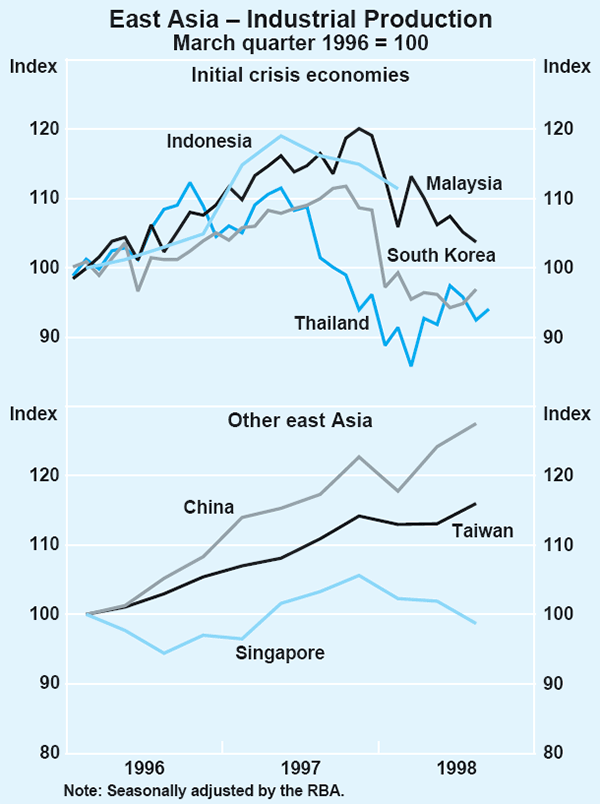
One factor which will be helping a number of the countries in Asia is that the decline in exchange rates has conferred a substantial boost to their exporters. Export values measured in US dollars have been flat, or in some cases fallen, over the past year. It is possible that in volume terms exports from Asia to the rest of the world are expanding noticeably, with falling US dollar prices and a decline in trade between countries within the region explaining the relatively weak US dollar value of exports. Nonetheless, a lack of access to trade credit may still be hampering export efforts, and of course the price of imports into the region, which are often used in the production of goods for export, has risen sharply.
Prospects for some stabilisation of domestic demand in many countries in Asia also appear to be improving. As noted in the chapter on ‘Financial Markets’, interest rates in most instances have been declining, and in a number of cases short-term market rates are now below those which prevailed prior to the onset of the crisis in the middle of last year. Budgetary restraint is also being eased, including in those countries under IMF programs. These trends are being assisted by the fall in the US dollar against the yen and the decline in US interest rates, which have eased the disparities in competitiveness between the countries in Asia, and allowed exchange rates against the dollar to be maintained at less cost to domestic economies.
Hence the short-term outlook for economic activity in east Asia, while hardly bright, appears to be improving. Prerequisites for a continued trend towards recovery are that markets for Asian goods in major countries continue to grow and remain open and that adequate domestic demand in Asia is sustained. The latter must be complemented by efforts to restructure and strengthen banking and corporate sectors, so that the benefits of more expansionary domestic policies can flow through to businesses and consumers. Progress appears to be being made on these fronts, though much remains to be done.
Domestic Economic Activity
Economic indicators so far in 1998 have been a little stronger than might have been expected given the deterioration in external conditions. Over the year to the June quarter, real output increased by just under 4 per cent, with slightly stronger growth experienced in the non-farm economy (Table 5). Growth has been sufficient to generate some solid gains in employment over the past year.
| Six months to: | Year to June 1998 |
||
|---|---|---|---|
| December 1997 | June 1998 | ||
| Expenditure | |||
| Private final demand(b) | 8.4 | 1.5 | 4.9 |
| Consumption | 6.5 | 3.2 | 4.9 |
| – Goods | 7.3 | 1.9 | 4.6 |
| – Other(c) | 6.9 | 4.9 | 5.9 |
| Dwelling investment | 8.9 | 14.7 | 11.8 |
| Business fixed investment(b) | 20.2 | −13.1 | 2.2 |
| – Equipment(b) | 21.8 | −17.7 | 0.1 |
| – Non-dwelling construction(b) | 15.7 | 0.6 | 7.9 |
| Public final demand(b) | 3.1 | 0.3 | 1.7 |
| Increase in private non-farm stocks(d) | −0.4 | 2.8 | 0.6 |
| Net exports(d)(e) | −2.2 | −3.8 | −1.6 |
| Gross domestic product | |||
| GDP(E) | 5.0 | 3.0 | 4.0 |
| GDP(A) | 3.7 | 4.1 | 3.9 |
| Non-farm GDP(A) | 4.1 | 4.3 | 4.2 |
| (a) All series are annually chained, except GDP(A) and non-farm GDP(A).
The series do not take into account changes relating to implementation
of SNA93. (b) Excluding transfers between the public and private sectors. (c) Excluding dwelling rent. (d) Contributions to growth in GDP(E). (e) Excludes RBA gold transactions. |
|||
There are a number of signs, however, that the economy is shifting to a pace of growth somewhat below trend. Business investment weakened in the June quarter, and investment in housing is levelling off, although housing affordability remains high. Stock-building is likely to be lower in the second half of 1998 than in the first half, contributing to some weakening in the growth of production. At the same time, household expenditure has continued to grow, driven in large part by employment gains which have boosted incomes, and by strong household borrowing.
The external environment remains the major source of uncertainty. Exports have been a drag on growth during the past year, primarily reflecting declines in exports to east Asia. Although this influence has to some extent been offset by increased sales to other regions, the external environment could become more difficult still particularly if growth in the US economy slows more sharply than currently expected. These uncertainties are also making it difficult for businesses to plan ahead, particularly in the mining and manufacturing sectors. Given the weaker external outlook and resultant uncertainties for the domestic economy, it is likely that overall growth in the Australian economy will decline over the year ahead.
Household income and expenditure
After a period of very strong growth in the second half of 1997, the rate of growth of private consumption has returned to something more like its longer-term trend. In real terms, retail spending increased by 1½ per cent in the September quarter after increasing slightly in the previous quarter (Graph 12). In part this uneven pattern reflects difficulties in capturing the changing seasonal pattern of retail sales around mid-year, and a more reliable indicator of the trend can be gained by taking the two quarters together; this suggests that sales over the recent period have been increasing at an annual rate of around 3 per cent. Spending has been supported by increases in household borrowings and by the recent pick-up in income and employment growth.
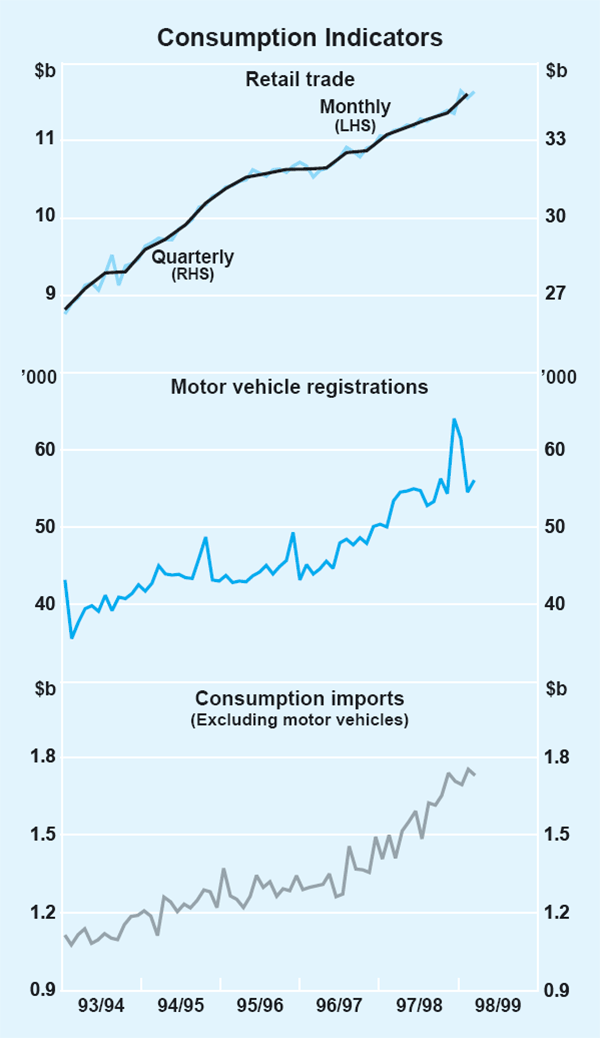
Retailers have experienced quite disparate conditions. Sales of food, hospitality, clothing and soft-goods have been strong, while household goods retailers have experienced falling sales over the past year. This pattern is a little surprising given the strength of housing investment, and may reflect a lag between stronger housing activity and expenditure on household items. If so, stronger spending on these items could be expected over the next few months; this would be consistent with results of the Consumer Sentiment survey, which show that a majority of consumers still feel it is a good time to buy a major household item. On the other hand, it is possible that increased car affordability has encouraged households to devote a greater share of disposable income to car purchases, and to defer purchases of household goods to some extent.
Over the year to June, spending on motor vehicles increased by 19 per cent. More recent data suggest that motor vehicle registrations have fallen back after their mid-year surge, though they remain at a high level. The immediate factors behind the very strong growth in sales of new cars have been a combination of competitive pricing and attractive financing deals. Competition in the car market was initially led by some imported brands which pressured domestic producers to reduce prices, and there has also been some aggressive discounting by dealers. Much of the strength in motor vehicle sales has been in the imported component, with vehicle imports rising by about 50 per cent over the past year. Low interest rates have seen a substantial increase in borrowing to finance vehicle purchases.
Longer-term factors also seem supportive of a high level of demand for cars. The average age of the Australian car fleet is relatively high by international standards, and has been rising since the 1980s. This suggests that new car sales during the 1990s have generally not been sufficient to replace scrapped cars as well as satisfy new demand, and that this difference between car sales and total demand has been met by extending the age of existing vehicles. The current level of motor vehicle registrations is much closer to what would be required to satisfy new demand.
Consumer sentiment, as measured in the Westpac-Melbourne Institute survey, has declined over the past year but remains above its long-run average. Continuing a trend that has been in evidence for much of the year, there is a contrast between attitudes to the economy as a whole and assessments of consumers' personal financial situations – consumers remain quite up-beat about their own circumstances while showing less confidence about the economy (Graph 13). Consumers' expectations about unemployment deteriorated slightly in October and remain below average.
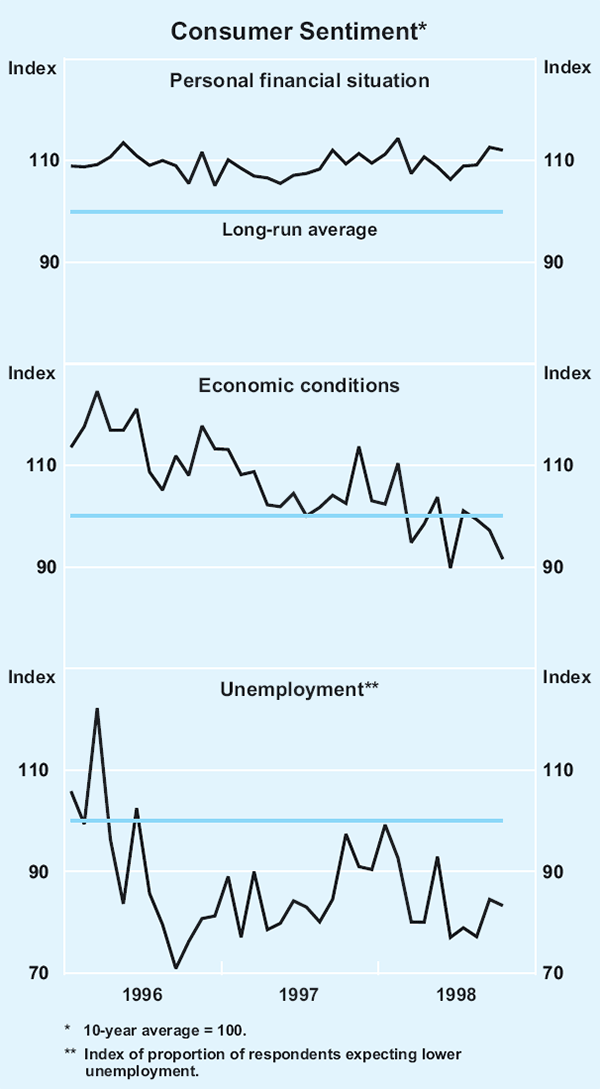
The easing in consumption expenditure in the first half of 1998 occurred in parallel with a slowing in household income. Real household disposable income increased by 3 per cent over the year to June, but at an annual rate of only 1 per cent in the first half of 1998. With spending still growing faster than income, however, the savings ratio has declined. The more recent healthy gains in employment should support income growth and spending, and may enable consumers to lift savings somewhat. Recognition of increased household wealth associated with the AMP demutualisation should be having its main effect in the second half of 1998 and will also be a supportive influence for household spending.
The housing market
Forward indicators of housing activity suggest that housing demand is now easing, although existing work in the pipeline should support some further expansion in construction activity over the next few quarters. Dwelling investment expenditure increased in the June quarter, to be 12 per cent higher than a year ago and around 30 per cent above its level at the start of the recovery in late 1996. As is usually the case, growth so far in this upswing has been mainly driven by construction of new dwellings, but investment in alterations and additions, which tends to be less cyclical, has also made an important contribution (Graph 14). There has also been a medium-term trend towards increased building of medium-density dwellings, probably reflecting demographic trends and increased community preference for that form of accommodation.
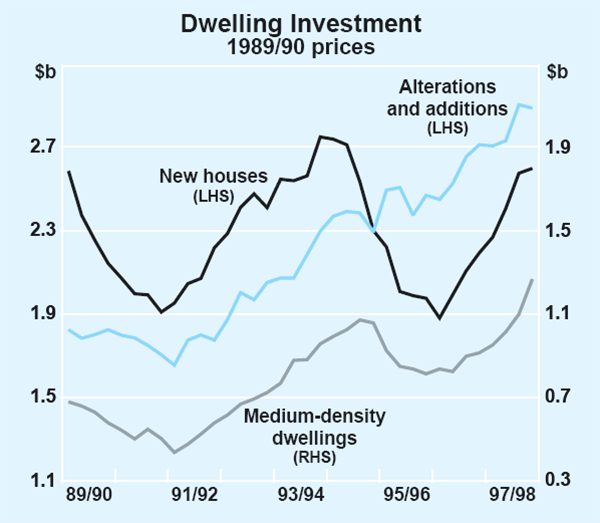
Loan approvals for housing have fluctuated considerably in recent months but have shown little net growth for some time. They remain at a high level, with the value of loan approvals over the past year having averaged around a third higher than the cyclical trough. The overall rise reflects a combination of increased numbers of loans approved and growth in the average loan size, which in turn reflects rising house prices and increases in the size and quality of homes constructed.
Trends in local government building approvals present a similar picture. By the middle of 1998, building approvals had increased by around 30 per cent, in terms of numbers of dwellings, from their cyclical trough, and by around 50 per cent in terms of total value. In recent months, however, building approvals have declined, and in the September quarter the number of approvals was 11 per cent below the June quarter level. This result seems consistent with the easing in demand suggested by loan approvals, although the recent figures may be less reliable than usual. Governments in New South Wales and Queensland have recently permitted private agencies to issue building approvals. This change has resulted in some local councils being slow in supplying complete building approvals data to the ABS.
Movements in house prices continue to reflect rather different demand conditions across capital cities. House price increases over the past year have been strongest in Sydney and Melbourne and, to a lesser extent, Perth and Adelaide. Within the Sydney and Melbourne markets, house price increases were initially led by strong rises in prices in the inner suburbs. These pressures have clearly eased in the past six months, even though prices in the middle and outer suburbs, which began to pick up somewhat later in the cycle, are still increasing.
The current housing cycle is different from previous episodes over the past two decades in some important respects. In particular, the run-up in housing approvals and commencements has not been as large, relative to underlying demand, as in previous cycles. The current upswing appears to be reaching a peak with a level of activity close to the medium-term level of underlying demand, in contrast to previous cycles when peak activity considerably exceeded underlying demand. An important reason for this is that there was not a particularly large backlog of excess demand at the time the upswing commenced. Another characteristic of the current upswing is that a greater proportion of activity is now accounted for by alterations and additions, which tends to be less cyclical than new construction. Finally, unlike previous cycles, the apparent peak in housing activity is occurring at a time of low interest rates and high levels of housing affordability, which should continue to support demand. All of these factors should make for a more dampened cyclical behaviour of the housing sector than has been typical in the past.
The business sector
While production continued to expand at a solid pace over the past year, national accounts data suggest that a significant part of overall production growth in the first half of 1998 was absorbed by stock-building. The increase in stocks was concentrated in the manufacturing sector, reflecting re-stocking after inventories were run down during 1997, although the slowing in manufactured exports may also have contributed. Despite the high level of stock-building, stocks-to-sales ratios of businesses do not look to be excessive; nor do surveys suggest any widespread intention to reduce stocks. Nonetheless, the high rate of stock-building seen in the first half of the year is unlikely to continue, a factor which would contribute to some dampening in the growth of production.
Measures of general business sentiment have been steadier in recent months after declining during the first half of this year. The NAB survey for the September quarter shows that indicators of expected business conditions, encompassing profitability, employment and trading conditions, rose slightly after weakening in June (Graph 15). Like consumers, businesses tend to be more pessimistic about the general economic outlook than in their assessments of their own circumstances. Exporters have shown the sharpest deterioration in confidence. The ACCI-Westpac survey of the manufacturing sector, which is quite heavily exposed to external demand, shows a bigger deterioration in confidence since the beginning of the year than recorded in other surveys, but also points to some stabilisation in confidence more recently. The Dun and Bradstreet survey, which gives greater weight to the service industries, gives a more positive reading overall, pointing to an expected rebound in sales and new orders in the December quarter. In general, the fact that most measures of confidence have stopped deteriorating in the recent period may reflect a recognition that firms' sales to the domestic market have continued to expand despite the deterioration in the international environment.
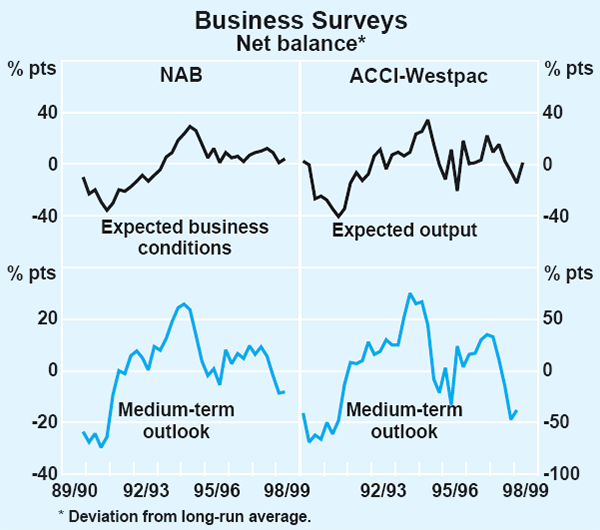
Business confidence may also have been shored up by stronger profit results recently. Following a fairly protracted period of moderate growth in profits, businesses have experienced some recovery in profitability over the past six months, according to official data. Total profits of the corporate sector, as measured by gross operating surplus, increased by 11 per cent over 1997/98 after increasing by just 1 per cent over 1996/97. This increase has seen gross operating surplus as a share of GDP rise to 15.6 per cent, somewhat above its decade average of 14.8 per cent. The strength in profits reflects the strong increase in domestic demand over the past year, which has helped businesses to achieve some good results particularly in the wholesale and retail, transport and storage, and services sectors.
Growth in profits of small business, as measured by the gross operating surplus of unincorporated enterprises, has also picked up in the past six months but has been more moderate than that for the corporate sector. As a share of GDP, profits of small businesses before interest, taxes and depreciation have remained relatively steady and at a level a little below their average for the past decade. The current low level of interest rates has contributed to a level of profits after interest at around 6½ per cent of GDP, marginally higher than their decade average.
Despite the resilience of profits in the March and June quarters, all of the major business surveys have indicated a downward revision in profit expectations for the next 12 months. In net-balance terms, profit expectations from both the NAB and ACCI-Westpac surveys are below their respective long-run averages, though well above their troughs of the last recession.
Business investment spending weakened in the first half of 1998. After allowing for transfers between the public and private sectors, new investment by businesses declined by 7 per cent over the first half of the year, with the weakness concentrated in the plant and equipment component. Despite the decline, the level of business investment in the June quarter was still 2 per cent higher than a year earlier, reflecting strong growth in equipment investment in the second half of 1997.
The recent decline in business investment comes after a period of around five years of strong growth during which investment in real terms had increased at an average annual rate of 10 per cent. Notwithstanding these strong increases over an extended period, businesses do not generally appear to be over-stretched in their investment spending at present. The upswing in business investment, coming off a low base in the early 1990s, has only returned investment spending to a level around its historical average in relation to GDP (Graph 16). This is true for both the plant and equipment and the construction components of investment spending. Other factors would appear supportive of further investment growth: corporate profitability is at above-average levels, as noted above, and interest rates are low. In these circumstances, the main immediate risk to the investment outlook would arise from the effect of the international economic downturn on business confidence.
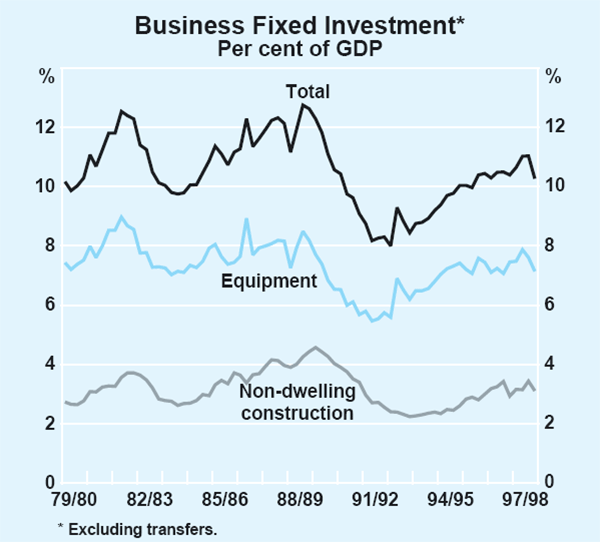
Business surveys are providing mixed readings as to investment intentions at present. Estimates from the latest ABS Capital Expenditure survey for 1998/99, conducted in late July and early August, suggest that, at this stage, businesses are still planning to increase their investment spending in the year ahead, though at a more moderate pace than has been typical in recent years (Graph 17). According to the survey, the expected level of capital expenditure over the year ahead was 12 per cent higher than the corresponding expectation recorded the previous year. This result, which refers to nominal spending, would imply a moderate increase in real terms, allowing for the expected increase in prices of imported investment goods.
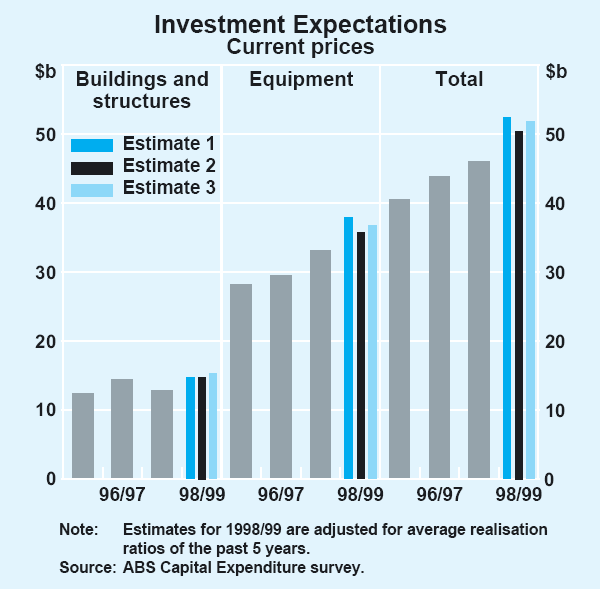
Most industries reported expectations of increased investment spending in 1998/99, with mining a notable exception. The recent scaling back of planned mining investment appears to reflect both the high levels reached in 1997 and weaker demand conditions in east Asia. The overall strength of the Capital Expenditure survey is somewhat at odds with business surveys that have reported a downgrading in investment plans. The NAB survey, for example, reported that capital expenditure plans have been revised down sharply in September after being largely unchanged over the previous few quarters.
Leading indicators of investment in buildings and structures (which represents around one quarter of total business investment) continue to be quite positive. Private non-residential building approvals picked up solidly in the June quarter (Graph 18). While these approvals have eased back in the September quarter, they remain at a level which would be supportive of further growth in construction activity over 1998/99. The recent strength in building approvals continues to be concentrated in New South Wales, which has accounted for nearly 45 per cent of total approvals over the past six months. The large stock of work yet-to-be-done for both non-residential buildings and engineering construction projects should also help underpin growth in construction activity in the near term. The strength in this area continues to be driven by a number of large private-sector infrastructure projects along with several large mining projects currently underway although, as noted above, planned investment in new mining projects is now being curtailed.
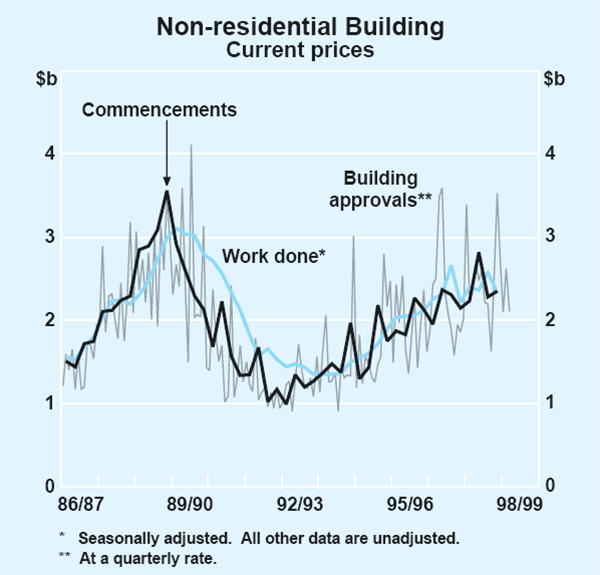
The labour market
The momentum in the domestic economy has contributed to a significant pick-up in employment growth over the past year. Over the year to September, total employment increased by 2.4 per cent, compared with an increase of 1.1 per cent the previous year (Graph 19). The most recent monthly figures suggest that employment continued to expand at a good pace through the September quarter, although not too much significance should be attributed to individual monthly movements. Since the start of the year, employment growth has been broadly matched by an increase in labour-force participation, with the result that the unemployment rate has remained steady, around an average of just over 8 per cent. In September the unemployment rate stood at 8.1 per cent, down by around 0.5 percentage points from the level prevailing in mid 1997.

The pick-up in demand for labour over the past year has been most evident in those industries which are usually most sensitive to the business cycle. Retail employment rose sharply in the three months to August, while employment in the construction industry is now 10 per cent higher than a year ago. In contrast, manufacturing employment has declined in each of the past four quarters, probably reflecting the impact of lower overseas sales by manufacturers. Public-sector employment, which declined during 1997, has risen slightly in recent quarters.
Full-time employment has performed well recently, increasing by 2.2 per cent over the past year and at a slightly faster pace over the past six months (Graph 20). This is a substantial pick-up from the flat or declining level of full-time employment recorded until late last year. Part-time employment has maintained a steadier upward trend in the past few years. The mix of employment growth between these two components typically reflects a combination of cyclical and longer-term influences. Most of the cyclical behaviour of employment in recent years has been accounted for by the full-time component, partly reflecting a greater-than-average intensity of full-time employment in industries that are cyclically sensitive. In contrast, the dominant longer-term influence is the more rapid average rate of growth of part-time employment. This reflects both changing work practices and an increasing community preference for part-time work.
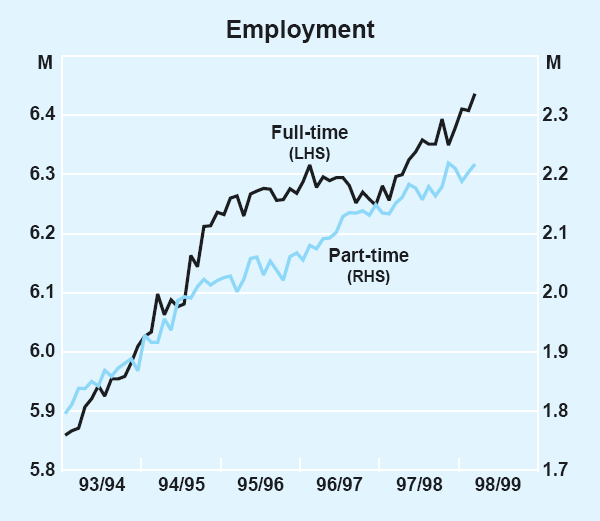
The pick-up in employment growth recorded over the past year follows a period of above-average growth in output, and appears consistent with the average relationship between output and employment evident over the 1990s. This lag accounts for much of the short-run variability in labour productivity. Thus, while activity growth eased slightly in the June quarter, the recent acceleration in employment resulted in a reduction in labour productivity growth from the exceptionally high rates recorded over 1997. Over the four quarters to June 1998, productivity per person in the non-farm sector increased by around 2 per cent, close to its average annual rate of increase during the 1990s.
Although businesses appear to be anticipating a decline in output growth, surveys do not seem to suggest that declines in confidence are having an independent dampening effect on labour demand. According to the NAB survey, businesses' employment expectations have declined somewhat since the start of the year but picked up in the September quarter (Graph 21). The survey also suggests that, like other aspects of business conditions, firms remain more optimistic as to their own likely employment levels than they do about the outlook for the economy more generally. Forward indicators of labour demand are still pointing to further gains in employment in the short-term. The ANZ and DEETYA measures of vacancies continue to rise, and in September both were more than 15 per cent higher than a year earlier. The ABS job vacancies series declined markedly in the September quarter, reversing sharp increases in March and June, but still showed private-sector vacancies to be 7 per cent higher over the past year.
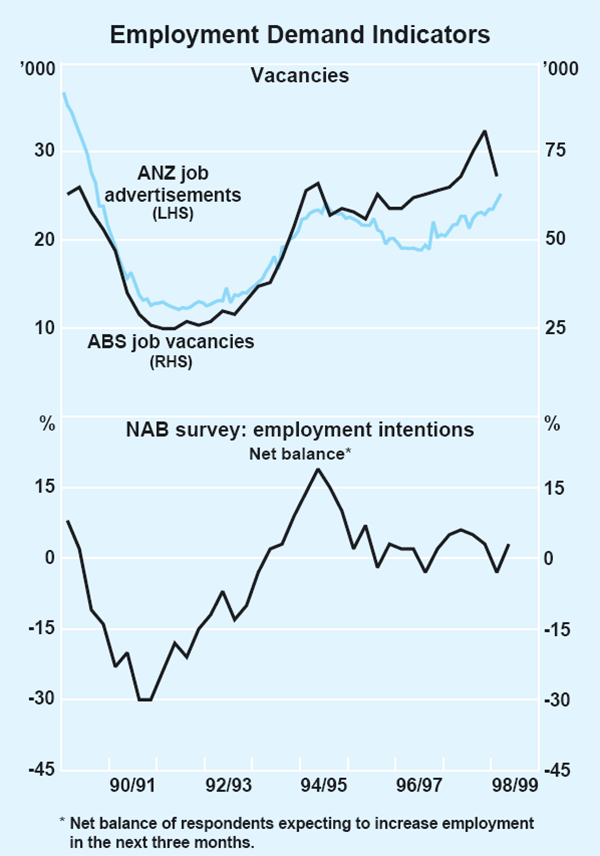
The rural sector
Farm output declined by 4.3 per cent in 1997/98, after a strong outcome including record crop production in the previous financial year. Following drought-breaking rains in the middle of the year, farm production is expected to rebound strongly in 1998/99. Although there has been some damage to crops from excess rainfall and frosts in some areas, the size of this year's wheat crop is currently anticipated by ABARE to be 21.9 million tonnes, which would be 13 per cent higher than the previous year and the second highest on record.
Conditions in the wool market have deteriorated as demand from the major wool-consuming countries (Japan, Korea, China and western Europe) weakens further. Wool exports fell by over 10 per cent in 1997/98. These conditions have prompted the Federal Government to propose legislation that would freeze sales of wool from the stockpile. The Government is also considering the possible sale of the stockpile. Improved saleyard prices, dry seasonal conditions in parts of Australia and the downturn in live cattle exports resulted in higher meat production in 1997/98. Meat exports to Japan and the US rose strongly in the year, offsetting the weakness in exports to South Korea and Indonesia.
Balance of Payments
Exports have weakened in response to the slowdown in Asia, though the ability of many exporters to find alternative markets for their products has meant that this reduction has been contained in some cases. Non-rural export volumes (excluding gold), fell in the December and March quarters, which was the period in which the loss of sales to Asia was concentrated. They then rose in the June quarter, but appear to have fallen again in the September quarter, to be about 4 per cent lower than a year earlier. This compares with an average annual rate of growth of 9 per cent recorded over 1990–96. Rural export volumes, which are largely supply determined, fell over the first half of the year, but from an historically high level (reflecting record farm production in 1996/97) and appear to have performed well in the September quarter.
The decline in exports to Asia was fairly widespread across countries, but particularly marked in the case of sales to Indonesia, Thailand and Malaysia. In contrast, exports to the US and EU have increased sharply since the Asian downturn (Graph 22). Excluding gold, the value of exports rose by around 22 per cent to the US, and by around 17 per cent to the EU over the four quarters to September. The share of these two destinations in Australia's total exports rose from 19 per cent in 1996/97 to around 22 per cent in the first three quarters of 1998. Exports to Japan strengthened through 1997, but have weakened subsequently.
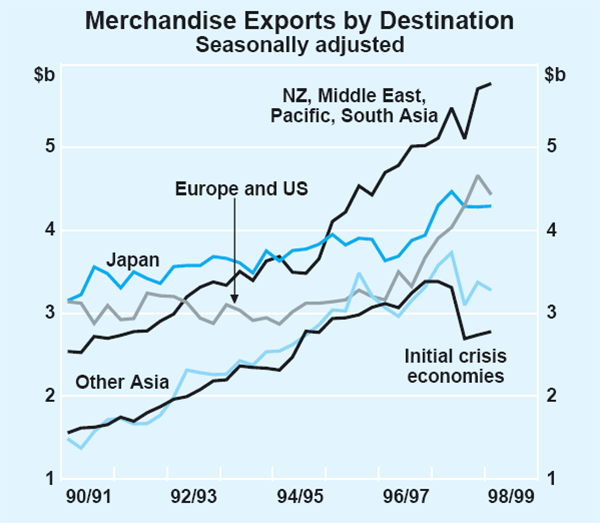
Diversion has been far more pronounced for resource exports than other merchandise exports. In fact, volume growth in resource exports (excluding gold) has been stronger over the past year than it has been through the 1990s. Most of this growth is in shipments of metal ores and minerals, coal and other mineral fuels, which together account for just under 60 per cent of resource exports. Gold exports also grew solidly over this period, but some of this is explained by re-exports of gold imported from Asia. Since the onset of the Asian crisis, both Australian gold imports and exports have grown strongly due to the re-processing of gold from Asia, and the re-exporting of this gold, mostly to the EU and Switzerland.
Exports of services have also been affected by the Asian crisis. As noted in the previous Semi-Annual Statement, tourist arrivals from the most troubled Asian countries fell dramatically in the second half of 1997. These now appear to have stabilised, at about 50 per cent of pre-crisis levels. Arrivals from other countries have shown a slight tendency to increase more quickly, helped by the lower exchange rate, but this has not offset the weakness in Asian tourism.
The pattern of departures by Australians appears to have responded to changed price incentives. Overall departures are increasing more quickly, but much of this appears to be explained by an increase in visits to New Zealand and Asia, presumably reflecting exchange rate developments; departures to the US and Europe have declined.
Growth in import volumes has slowed. In part this reflects the fact that growth in domestic demand has declined from very high rates in 1997, but a lower exchange rate is probably also playing a role. Imports of goods and services increased at an annual rate of a little under 6 per cent over the first half of 1998, compared with an annual rate of over 9 per cent over the second half of 1997. The most recent trade data suggest a further decline in growth of import volumes in the September quarter.
| Average annual growth 1990–95 |
Year to latest 3 months(a) |
|
|---|---|---|
| Visitor arrivals | ||
| East Asia | 18.4 | −15.7 |
| of which: | ||
| – Initial crisis economies |
32.3 | −51.2 |
| – Japan | 10.3 | −9.3 |
| – Other east Asia | 24.0 | 11.8 |
| United States and Europe |
5.5 | 7.4 |
| New Zealand | 5.2 | 10.6 |
| Rest of the world | 8.8 | 13.8 |
| Total | 11.0 | −3.2 |
| Departures of Australian residents | ||
| East Asia | 5.0 | 8.1 |
| of which: | ||
| – Initial crisis economies |
3.5 | 13.0 |
| – Japan | −2.3 | 7.9 |
| – Other east Asia | 8.1 | 1.1 |
| United States and Europe |
1.4 | −1.2 |
| New Zealand | 3.0 | 17.8 |
| Rest of world | 3.2 | 11.1 |
| Total | 3.0 | 5.8 |
| (a) For arrivals, latest data are for August 1998; for departures, latest data are for July 1998. | ||
Weaker growth is seen across most of the categories. Growth in consumption imports has declined considerably from its strong start to the year, driven primarily by a levelling off in motor vehicle imports. Growth in imports of capital goods has also slowed, while service import volumes have been falling for some time.
As a consequence of the recovery in exports and the slowing growth of imports in the June quarter, the trade deficit narrowed to 1.3 per cent of GDP, from 1.7 per cent in March. This in turn contributed to some improvement in the current account deficit which declined to 4.7 per cent of GDP (Graph 23). Although commodity prices have fallen considerably over the last year (see ‘Commodity prices’ section), the weaker currency over 1998 has ensured that export prices expressed in Australian dollars have remained reasonably steady. However, the terms of trade are now declining as import prices rise in response to the earlier depreciation of the exchange rate. Thus, while export and import volumes have been relatively flat in the September quarter, the deterioration in the terms of trade is likely to result in some widening in the trade deficit, to around 1¾ per cent of GDP in the quarter. This will be reflected in the current account deficit.
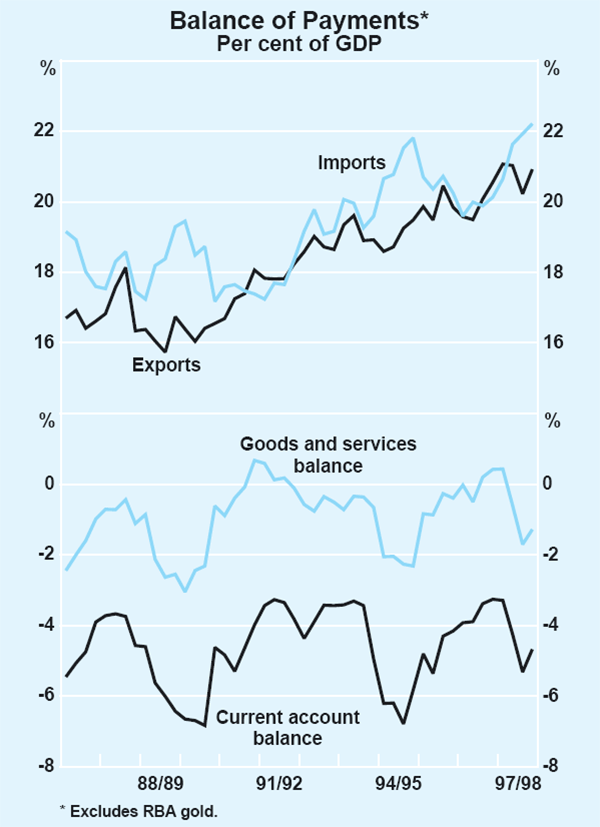
Australia's net foreign liabilities have remained around 60 per cent of GDP over the past two years or so; two-thirds of these liabilities are debt. While a significant proportion of Australia's gross foreign debt is short term and denominated in foreign currencies, the majority of this debt is owed by the official and financial sectors and is largely hedged. While practice among private corporations varies, a significant proportion of their foreign debt has also been hedged, either through financial markets transactions or through ‘natural hedges’ because it is matched by foreign-currency revenues.
Australia's ability to service its foreign liabilities, as measured by the ratio of interest and dividend payments to exports, remains near its historical (post-deregulation) average and significantly below the levels over the past few years. The bulk of Australia's net income deficit is accounted for by interest payments on foreign debt. Despite the substantial depreciation of the exchange rate over the past year, the net income deficit as a proportion of exports has been broadly unchanged. This reflects the fact that higher interest payments on net foreign currency debt in $A terms have been broadly matched by higher income receipts on net foreign-currency equity assets.
Commodity prices
Commodity prices have continued to fall. In SDR terms, Australia's commodity prices are now around 19 per cent below the peak recorded prior to the onset of the Asian crisis (Graph 24). Price falls have been spread across most components, but continue to be most pronounced for rural goods and base metals. In the three months to October, the falls were concentrated in rural goods, whose prices fell by over 9 per cent, and base metals, whose prices fell by 5 per cent.
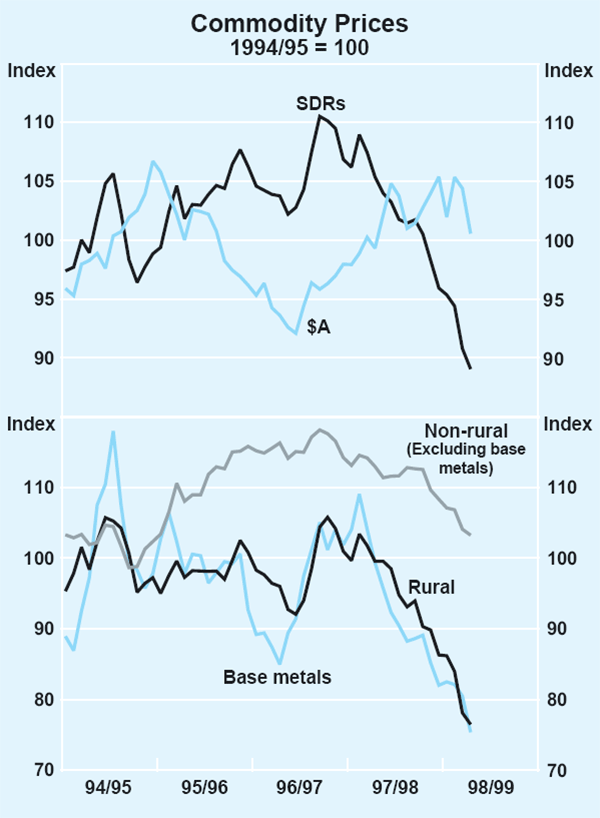
Weaker demand growth in some of the major industrial countries is likely to be the main explanation for these falls. It is sometimes suggested that economic downturns in a number of developing countries may also affect commodity markets substantially. Slower output growth in the emerging markets certainly implies that their own demand for commodities is lower, which at the margin must be exerting downward pressure on prices, but this is still likely to be less important than developments in Japan, the US or Europe.
On the supply side, it has been suggested that those emerging markets that produce commodities could seek to acquire foreign exchange by dumping produce onto world markets, reducing prices and disrupting other countries' exports of commodities. Table 7 shows the countries which are important suppliers of some commodities which Australia exports.
| Share of world production |
Share of production exported |
|
|---|---|---|
| Per cent; 1995 | ||
| Coal | ||
| Australia | 5.3 | 70.8 |
| China | 35.7 | 2.1 |
| FSU | 9.0 | 5.8 |
| United States | 23.6 | 9.4 |
| Iron ore | ||
| Australia | 14.3 | 93.5 |
| Brazil | 17.5 | 73.7 |
| China | 24.6 | – |
| FSU | 13.3 | 23.4 |
| Gold | ||
| Australia | 11.1 | 100.0 |
| FSU | 9.1 | 96.8 |
| South Africa | 23.0 | 70.5 |
| United States | 14.5 | 0.0 |
| Aluminium | ||
| Australia | 6.6 | 74.0 |
| Canada | 11.1 | 78.8 |
| Russia | 13.9 | 88.8 |
| United States | 17.2 | 13.3 |
|
Source: ABARE |
||
The extent of these pressures should not be overestimated, however. For one thing, it is not clear how much short-run additional production capacity these producers have. In the countries of the Former Soviet Union (FSU), a need for export income over a number of years had already resulted in a substantial increase in commodity production earlier in this decade. If even higher rates of production were not previously viable, then falling commodity prices will make them less profitable now. These producers also might find it difficult to invest in new plants, which take a considerable time to come on-stream in any event, due to the problems in the financial sectors in many of these countries and the difficulty in attracting foreign capital.
In summary, it is not clear that increased supply by emerging market countries will place much additional downward pressure on commodity prices. The outlook for growth in the industrial countries is still likely to have the largest influence on commodity prices.
It is worth noting as well that price falls to date are not as large as the falls seen in several previous episodes (Box C), though further declines might yet occur. For example, industry analysts suggest that Japanese steel producers will be seeking lower prices for iron ore and coking coal in negotiations with Australian producers currently under way.
Despite the continued weakness in commodity markets, the depreciation in the Australian dollar against the major currencies has meant that, in domestic-currency terms, commodity prices are currently a little above their level prior to the onset of the crisis in Asia. This is supporting the profitability of rural and resource producers.
Box C: The Impact of the World Economic Slowdown on Australia
There has been much discussion of the effect of the Asian economic slump on the Australian economy. To date, the main direct impact has been seen in reduced exports to east Asia. Less easily quantifiable is the potential impact on Australia of the broader world slowdown now expected by official forecasters. This box provides a perspective on the economic downturn, by outlining channels through which the Australian economy is being affected, and comparing the overall external slowdown with previous episodes.
Channels of influence
Export quantity effects
Exports to Asia fell towards the end of 1997 and in the first few months of 1998. By mid 1998, exports to the initial crisis economies – Thailand, Korea, Indonesia, Malaysia and the Philippines – were one third or more below the level where they might have been had trend growth of the previous five years continued. In addition, exports have declined to other Asian countries which were not immediately part of the crisis, but which were subsequently affected, such as Hong Kong, Singapore, China and Taiwan.
The decline in sales to Asia has been partly offset by increased sales elsewhere, including the United States and Europe. The diversion of exports was particularly pronounced for resources, where growth in volumes over the past year has not slowed at all, and has been higher than the average for the 1990s. Exports of manufactures and services have been hit, with the result that total non-rural exports (excluding gold) have declined over the past year.
Terms of trade effect
The loss of sales to Asia accounts for only part of the loss to Australians from the deterioration in international trading conditions. In foreign currency terms, lower prices are being achieved for the bulk of Australia's exports to all destinations. This amounts to a fall in Australia's terms of trade – that is, the purchasing power of Australia's exports in terms of imports has declined. Between mid 1997 and the September quarter of 1998, the terms of trade is estimated to have fallen by about 4 per cent. This lowers the purchasing power of national income.
The absolute fall in commodity prices has been more than offset by the decline in the exchange rate, so that in Australian dollar terms export prices have in fact risen. In other words, the income loss which arises from a decline in the terms of trade has been passed on to users of imports.
Indirect effects
There are also potential indirect effects of the external changes. Lower income growth, occasioned by lost exports and lower terms of trade, can be expected to result in lower growth in aggregate demand, and therefore some further reduction in growth in domestic output compared with what otherwise would have occurred. It is likely these forces are beginning to affect the economy now. There is also the possibility of confidence effects, should business or households abruptly curtail their spending plans independently of current income. So far, these effects appear to have been quite minor, though confidence could remain vulnerable to further deterioration in external conditions. Working in the other direction, the increase in the relative price of imports should induce substitution away from imports and towards domestic import-competing goods and services, adding to domestic output.
Historical comparison
Graph C1 and Table C1 compare this episode with previous downturns in world economic growth over the past two decades, using a number of different benchmarks. The current downturn in world economic growth, as estimated by the IMF, is of comparable size to that in the early 1990s but is somewhat less than that in the early 1980s or mid 1970s. This estimate reflects the weakness in east Asia and Japan as well as an assumed moderate decline in growth in the United States. The decline in growth in Australia's particular group of trading partners is much more substantial than anything seen in the past two decades. However, the resilience of the economy to date suggests that it is global growth, rather than growth in trading partners, which is of most importance. Both the decline in the terms of trade and the fall in commodity prices to date are less than those of the previous three episodes, noticeably so for the terms of trade. Exports have declined in volume terms by a little more over the past year than in the two preceding episodes, though the fall in the early 1980s was much larger.

| Episode | Terms of trade | RBA commodity price index (SDRs) |
Export volume growth(a) |
|---|---|---|---|
| 1. Early 1980s | −13.3 | – | −12.2 |
| 2. Mid 1980s | −15.5 | −29.7 | −1.9 |
| 3. Early 1990s | −14.4 | −23.1 | −1.4 |
| 4. Late 1990s to date | −4.0(b) | −18.1 | −3.6(b) |
|
(a) Lowest annual rate of growth of non-rural export volumes (excluding gold) reached
during episode. (b) Estimate to the September quarter 1998. |
|||
Financial Conditions
Intermediaries' interest rates
Even though there has not been any change to monetary policy in the past six months, interest rates faced by many borrowers have continued to come down as competition among banks has reduced their margins. For example, the average indicator rate on small business loans fell over the June quarter, from 8.75 per cent to 7.7 per cent (Graph 25). Loans secured by residential property generally attract no risk margin and are frequently offered at rates below the average variable rate; predominant indicator rates on residentially secured facilities are 6.9 and 7.2 per cent for term loans and overdrafts respectively.
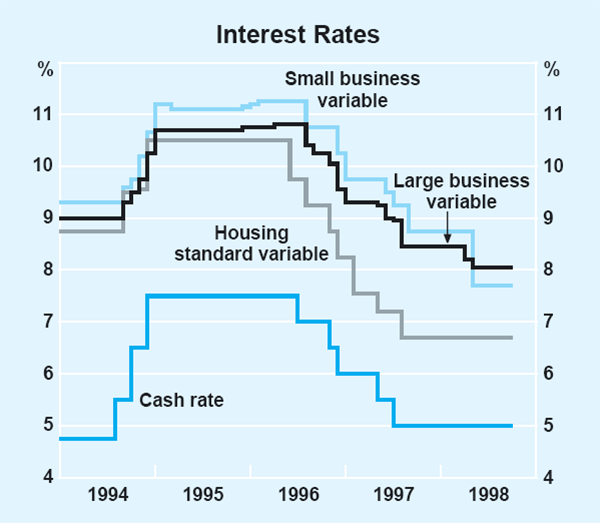
In the case of housing loans, banks' interest rate on standard variable-rate loans has remained largely unchanged, at 6.7 per cent since late 1997, while mortgage managers' variable rates have been steady at 6.3 per cent. However, many banks have recently reduced honeymoon rates by approximately 50 basis points to around 5.5 per cent, and some mortgage managers have begun to offer these products. With margins on housing loans having narrowed considerably across the board in recent years, financial intermediaries seem to have returned to the strategy of earlier in the 1990s, whereby banks and mortgage managers focused their competitive energies on attracting new customers.
Taking a longer-term perspective, since mid 1996, when the first of the five easings in monetary policy took place, rates for a wide range of variable-rate loans have fallen by more than the cash rate. This is illustrated by figures in Table 8, which show movements in these interest rates. The table also includes figures for the overall cost of business loans, where available, which incorporate customer risk margins in addition to the relevant indicator rate.
| Movement between June quarter 1996 and September quarter 1998 Percentage points | |||
|---|---|---|---|
| variable-rate loans | Fixed-rate loans | ||
| Housing | Housing(c) | −2.8 | |
| Standard variable | −3.8 | ||
| Basic | −2.8 | ||
| Honeymoon | −2.1 | ||
| Small business | Small business | ||
| Indicator rates | Indicator rate(c) | −2.9 | |
| – Overdraft | −3.6 | Average overall rate(a) | −1.9(b) |
| – Residential-secured overdraft | −4.7 | ||
| – Residential-secured term | −3.6 | ||
| Average overall rate(a) | −3.6(b) | ||
| Large business | Large business | ||
| Overdraft indicator rate | −2.8 | Indicator rate(c) | −3.0 |
| Average overall rate(b) | −2.9(b) | Average overall rate(a) | −1.9(b) |
| Cash rate | −2.5 | Three-year swap rate | −2.9 |
| (a) Customer risk margins included. (b) Latest available data are for the June quarter 1998. (c) These indicator rates are for fixed-rate loans with terms of three years. |
|||
Since mid 1996, the predominant interest rate on standard-variable housing loans has fallen by 3.8 percentage points, or 1.3 percentage points more than the cash rate. The average overall rate paid on small business variable-rate loans has fallen by 3.6 percentage points, or 1.1 percentage points more than the cash rate since mid 1996. Interest rates on these loans are well below the previous cyclical trough in 1993, and in fact are the lowest for about 30 years (Graph 26).
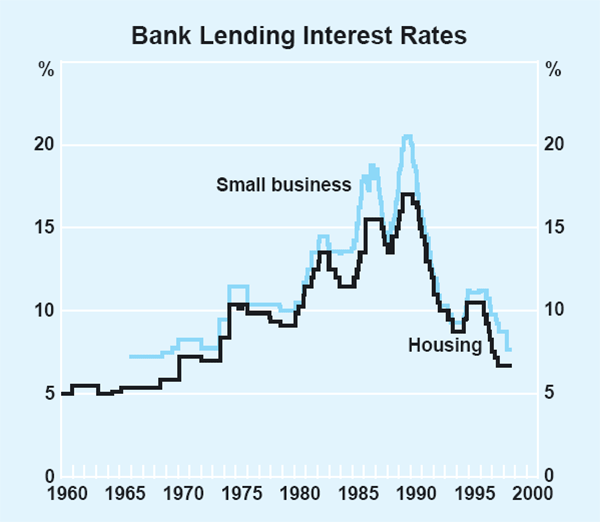
Fixed-rate loans, about 20 per cent of banks' total loans, are generally priced from yields of comparable term in swap markets and, accordingly, margins on these loans are better measured relative to movements in swap rates rather than the cash rate. The figures in Table 8 show that, since mid 1996, indicator interest rates on fixed-rate products for terms of three years have moved broadly in line with the swap rate – i.e. margins on these loans have not come down as in the case of variable-rate loans, as they had always been significantly lower. These rates, of course, apply only to new loans. The average interest rate received on all outstanding fixed-rate business loans has fallen by about a percentage point less than the swap rate, because the fall in indicator rates has not yet worked its way through the stock of outstanding loans.
Banks have also been aggressive in the personal lending market. While variable interest rates on banks' instalment loans have not changed, those on residentially secured lines of credit – the fastest growing sector of this market – have fallen by 40 basis points, to around 7 per cent, since the start of the year. The interest rate is much lower than that for traditional instalment loans, which average 9.4 per cent if security is offered, and 12.4 per cent if the loan is unsecured.
In contrast to loan rates, which have generally fallen by more than the cash rate in recent years, the average interest rate paid by banks on deposits has fallen by less than the cash rate. This is because the cash rate is not a comprehensive measure of banks' total cost of funds, as banks fund their lending from a variety of sources, including retail deposits, wholesale deposits, debt issues and overseas capital markets. Most notably, interest rates on transaction and investment accounts have fallen only slightly, because they were already at low levels.
With interest rates on loans falling by more than those on deposits, the interest spread of banks has declined in the past year. The overall interest spread is shown on Graph 27. Since 1996, this spread has declined from 3.8 per cent to 3.2 per cent. This is part of a longer-term decline from around 5.0 per cent in 1980 – an early point in the process of deregulating financial markets in Australia.
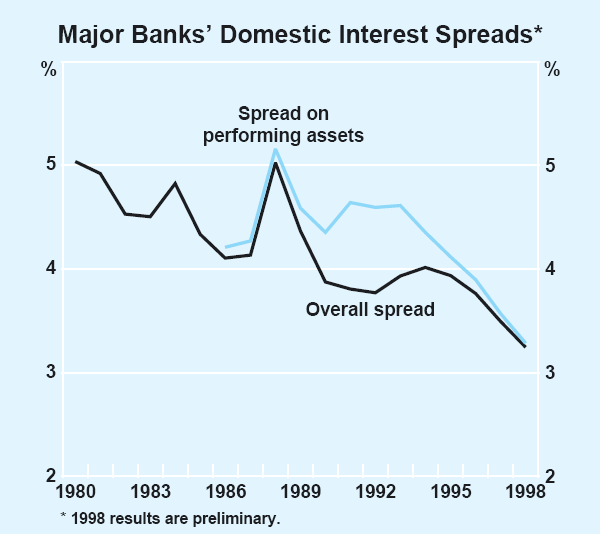
Real interest rates
Measures of real interest rates (defined as nominal interest rates adjusted for expected inflation) continue to suggest that these are below historical averages, as is to be expected when monetary policy is seeking to have an expansionary impact on the economy. While there is no single definitive measure of real interest rates, as they depend on inflation expectations which are not directly observable, several estimates based on either actual past inflation or survey measures of expected inflation are shown in Table 9. Declines in real borrowing rates over recent years reflect a combination of reduced cash rates and compression of intermediaries' lending margins; in recent months there has also been some increase in inflation expectations (discussed in detail in the chapter on ‘Inflation Trends and Prospects’), which also acts to reduce some measures of real interest rates. According to the measures reported in Table 9, real interest rates on standard variable-rate loans both for housing and small business are now below their cyclical troughs reached in the early 1990s, by a percentage point or more. Real cash rates are above their trough but lower than their average over the past five years. Real interest rates as measured by yields on indexed bonds are also near historical lows at about 3.5 per cent, roughly a percentage point below their average for the 1990s.
| October 1998 |
Early 1990s trough |
5-year average |
|
|---|---|---|---|
| Calculated using underlying inflation | |||
| Cash rate | 3.3 | 2.5 | 3.8 |
| Housing loan rate | 5.0 | 6.4 | 6.4 |
| Small business variable rate(a) | 5.8 | 7.0 | 7.4 |
| Large business variable rate | 6.3 | 6.7 | 7.2 |
| Calculated using Melbourne Institute survey | |||
| Cash rate | 1.3 | 0.2 | 2.0 |
| Housing loan rate | 2.9 | 4.1 | 4.6 |
| Small business variable rate(a) | 3.7 | 4.6 | 5.6 |
| Large business variable rate | 4.2 | 4.3 | 5.4 |
| Indexed bond yield | |||
| 7-year | 3.5 | 3.2 | 4.6 |
| 12-year | 3.5 | 3.1 | 4.5 |
| (a) From December 1996, calculated as the average of the four major banks' variable rates; prior to that, the predominant rate is used. | |||
Financial aggregates
Credit growth has eased slightly in recent months (Table 10), although the overall expansion of credit, at a rate of 10.9 per cent over the past year, remains well in excess of the economy's nominal growth rate. The moderation is attributable to a decline in the rate of growth of business credit which, after a period of quite rapid growth in the second half of 1997 and some strength in the middle of this year, has slowed to a rate of 7 per cent over the past three months. Lending for housing strengthened over the first half of the year, but has shown some signs of easing off in August and September. Personal credit continues to grow rapidly.
| Year to Sep 1998 |
Three months to: | ||
|---|---|---|---|
| Jun 1998 | Sep 1998 | ||
| Total credit | 10.9 | 11.2 | 9.6 |
| – Personal | 16.8 | 14.6 | 18.0 |
| – Housing | 11.2 | 13.2 | 10.6 |
| – Business | 9.4 | 9.0 | 7.1 |
| Currency | 8.9 | 5.2 | 14.2 |
| M1 | 7.3 | 19.8 | 3.4 |
| M3 | 7.6 | 10.5 | 13.2 |
| Broad money | 7.2 | 7.8 | 12.5 |
Over the course of 1998 growth rates in the broader deposit-based monetary aggregates, M3 and broad money, have increased significantly, bringing them more into line with credit growth. The stronger growth in M3 has been driven mainly by issues of certificates of deposit by banks. Broad money has increased less quickly than M3, reflecting little growth in deposits with non-bank financial intermediaries. Corresponding with the overall increase in deposit growth, financial intermediaries have been funding less of their credit expansion over the past six months through net raising of funds abroad. Currency growth, after initial signs of softening earlier in the year, has strengthened over the past couple of months, perhaps partly reflecting recent strength of spending by consumers.
| 1996 | 1997 | 1998 | |
|---|---|---|---|
| Cash management trusts | 21.6 | 50.2 | 54.7 |
| Unit trusts | 15.5 | 32.6 | 25.7 |
| of which: | |||
| – Property trusts | 14.4 | 22.2 | 21.7 |
| – Equity trusts | 19.7 | 45.4 | 20.6 |
| – Mortgage trusts | 24.4 | 42.6 | 22.8 |
| Life offices | 6.3 | 12.4 | 7.9 |
| Superannuation funds | 13.9 | 22.0 | 14.0 |
| Total | 10.6 | 19.8 | 14.4 |
|
Sources: ABS Cat. Nos 5655.0 and 5645.0 |
|||
Funds under management rose firmly in the June quarter, with growth remaining particularly strong in cash management and public unit trusts. While the bulk of assets of these funds is held in domestic equities, recent uncertainty in financial markets appears to have encouraged fund managers to increase their exposure to cash and deposits in the last two quarters. The strong inflows of funds to cash management trusts and negative valuation effects in equity funds also boosted overall exposure to cash.
The expansion of managed funds is part of a longer-term shift in the destination of savings, which has seen a decrease in the reliance on traditional low-interest savings vehicles and a substitution towards higher-yielding assets such as shares or managed funds. These changing consumer attitudes can be seen from the Westpac-Melbourne Institute Survey of Consumer Sentiment, which traces the long-term decline in consumers' preferences for deposits, and their increasing attraction towards equity investments (Graph 28). This change in households' perceptions has been particularly marked over the past five years.
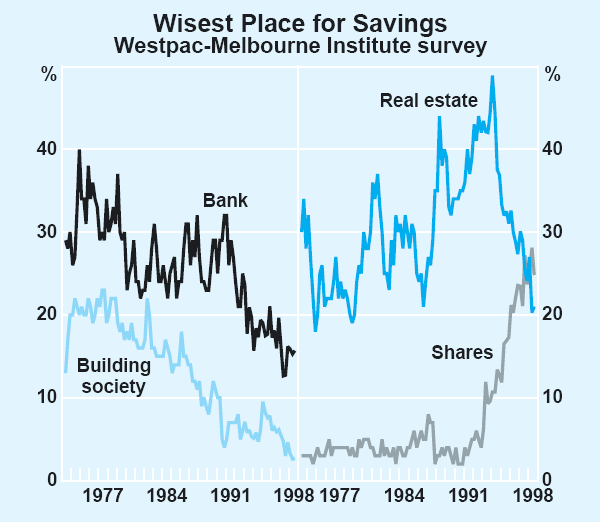
Household finance
The strong growth in personal credit over the past year reflects the favourable borrowing conditions which have helped to support household spending. There has been rapid growth in revolving credit in the form of overdrafts and credit-card lending. Banks have continued to encourage these forms of borrowing through the promotion of overdraft products, particularly those secured by residential property, and the use of reward programs associated with credit cards. Over the past year the number and value of credit-card transactions has increased by 30 per cent, far outstripping the growth in consumer spending. To some extent this trend reflects a change in consumers' means of payment rather than a change in their net financial position. Nonetheless, credit-card debt outstanding to banks has increased by around 20 per cent over the past year. Motor vehicle finance has also expanded rapidly, in line with the growth in demand for cars. In aggregate, households appear to have remained sufficiently comfortable with their financial circumstances to take advantage of the current favourable borrowing conditions, with the result that household spending over the past year has increased more quickly than incomes.
Total household borrowing, comprising borrowing for housing and for other personal purposes, increased by 13 per cent over the year to September, considerably faster than the growth of household incomes. This has resulted in a continued upward trend in the ratio of household debt to disposable income (Graph 29). However, there has not been a commensurate increase in household interest payments, which have remained relatively stable as a share of household income since early last year. This in turn suggests that average interest rates paid have tended to fall, reflecting reduced rates on some personal loans and on fixed-rate home loans. Mortgage managers may also have contributed to lower average interest payments. The debt-servicing burden of households remains well below recent peaks.
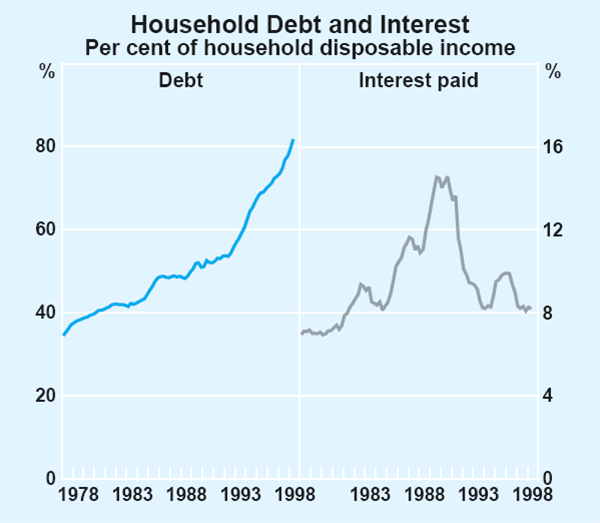
Business finance
Consistent with the pattern in business credit, funding from other sources showed strength around the middle of the year but appears to have eased recently. According to the quarterly financial accounts, the corporate sector raised $10.7 billion in new equity in the June quarter and $12.8 billion of debt, after quite small raisings in the March quarter. Indications for the September quarter are that financial market conditions were less conducive to corporate debt and equity raisings from the market. Reflecting good profit growth in the recent period, internal funding from retained earnings is at a high level. In the June quarter, the level of retained earnings was equivalent to 8½ per cent of GDP, compared with a decade average of 8 per cent, and accounted for around a third of total corporate funding.
High average levels of equity raisings over the past two years have seen the corporate debt to equity ratio in the non-financial sector levelling out at fairly moderate levels (Graph 30). The combination of moderate gearing ratios and low interest rates means that the corporate sector's interest burden remains well below its historical average.
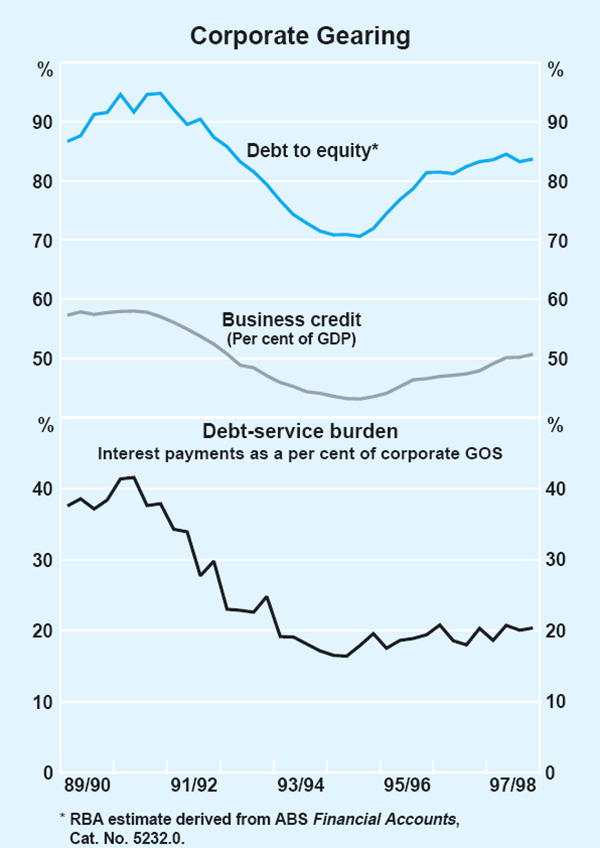
Inflation Trends and Prospects
Recent developments in inflation
Consumer prices
Inflation remains low, but with signs of a gradual pick-up. The Treasury underlying CPI increased by 0.4 per cent in the September quarter, the same as in the previous quarter, to leave the annual rate at 1.6 per cent, up slightly from the low point reached last December. Other estimates of core or underlying inflation confirm a slight pick-up in inflation from the recent trough, but all show an inflation rate of less than 2 per cent over the past year (Table 12, Graph 31).
| Quarterly | Year-ended | ||||
|---|---|---|---|---|---|
| Jun 1998 | Sep 1998 | Dec 1997 | Sep 1998 | ||
| Headline CPI | 0.6 | 0.2 | −0.2 | 1.3 | |
| ‘Acquisitions’ CPI(a) | 0.5 | 0.2 | 1.5 | 1.8 | |
| Treasury underlying CPI | 0.4 | 0.4 | 1.4 | 1.6 | |
| Private-sector goods and services | 0.3 | 0.2 | 1.3 | 1.5 | |
| Median price change(b) | 0.5 | 0.4 | 1.8 | 1.9 | |
| Trimmed mean price change(b) | 0.5 | 0.2 | 1.7 | 1.7 | |
|
(a) Excludes mortgage interest and consumer credit charges, but includes house prices.
For more details see Box D. (b) For definitions, see ‘Measuring Underlying Inflation’, Reserve Bank of Australia Bulletin, August 1994. |
|||||
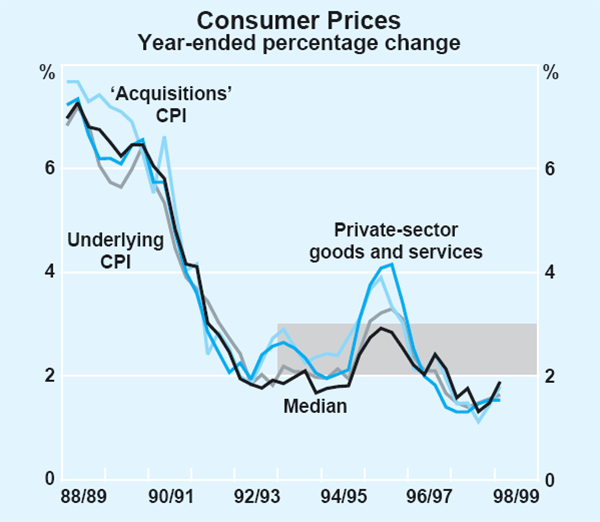
Private-sector goods prices have been more subdued than services prices over the past year, increasing by 1.2 per cent. Prices of imported goods included in the CPI, as discussed below, have continued to decline, although there have been strong increases recorded in import prices at the wholesale level. At the same time, domestically produced goods have recorded only small increases. The absence of strong price pressures for domestically produced goods suggests that the business environment faced by producers remains competitive, and may also reflect rapid productivity growth in the recent period which has helped to hold down growth in unit labour costs. Private-sector service price increases, after running at a rate of over 3 per cent for some time, eased in the September quarter to show an increase of 2.4 per cent over the year (Graph 32).
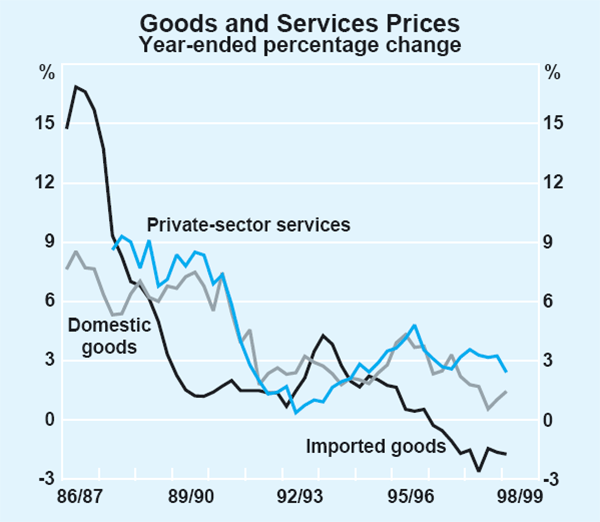
The Consumer Price Index increased by 0.2 per cent in the September quarter, and by 1.3 per cent over the year. The quarterly increase was held down slightly by declines in petrol prices and by reduced gas and electricity costs associated with the Victorian Winter Power Bonus and Energy Concession Scheme.
This is the first quarter of data for the 13th series CPI which, as discussed in detail in Box D, contains some important changes in the method of calculation. For monetary policy purposes, the most important of these changes is the adoption of an ‘acquisitions’ approach to the measurement of housing costs and other items purchased on credit. In practical terms this means that mortgage interest charges and consumer credit charges are now excluded from the index, while the purchase price of new houses (excluding land) is included. Since the CPI is not revised, the historical series remains under the previous basis up to the June quarter 1998. As a result, the change in the CPI over the year to September 1998 is still affected by interest rate reductions that were being passed on to borrowers in the December quarter last year. The Bank's estimate of a consistent acquisitions-CPI, which excludes this effect, shows an increase over the year of 1.8 per cent. This has picked up from a rate of 1.4 per cent over the year to the June quarter (Graph 31).
The exchange rate and import prices
The decline in the exchange rate over the past year or more has important implications for the outlook for inflation. The effect of these movements occur in two phases. The first, in which wholesale prices of imports respond to the lower exchange rate, typically occurs quite rapidly, over the space of six months or so. The second stage, involving the pass-through of higher prices across the docks to consumers, typically takes much longer.
In evaluating the first stage of this process, the situation is complicated to some extent by the divergent movements in the Australian dollar against major currencies compared with its movement against Asian currencies. Since the middle of 1997, the exchange rate has declined by around 17 per cent against the currencies of the major industrial countries, and by 7 per cent overall in ‘import weighted’ terms (Table 13), reflecting the share of Asian countries in the sources of Australian imports. Movements in wholesale import prices recorded in the recent period appear to have been larger than would be explained by movements in the import-weighted exchange rate; over the past year, import prices at the docks, as measured by the import price index, have increased by 11 per cent, and they are 14 per cent higher than at their trough in the June quarter 1997 (Table 13, Graph 33), with some further rise likely. This appears to reflect the disproportionate influence of the major industrial countries on world prices of the goods that Australia imports. The rise in import prices also suggests that this first stage of pass-through of the currency depreciation has, as is typical, occurred quite quickly.
| Mid 1997 to Sep qtr 1998 |
|
|---|---|
| Trade-weighted exchange rate | −2.1 |
| Import-weighted exchange rate | −7.2 |
| Against SDR | −16.9 |
| Against US dollar | −19.3 |
| Import price index | 13.9 |
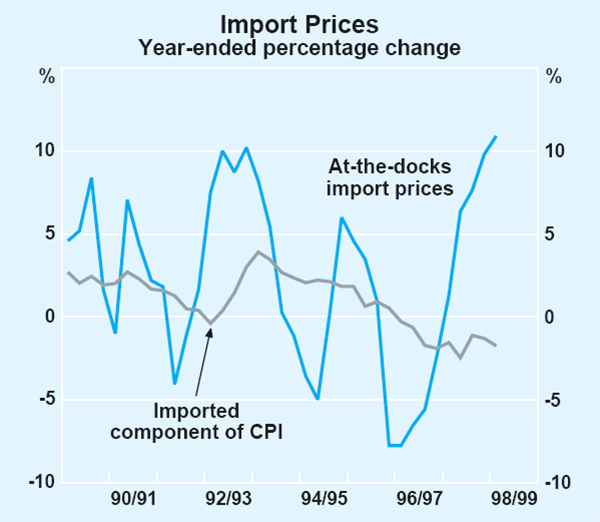
The increases in import prices at the docks have yet to flow through, however, to prices paid by consumers. In the September quarter, the imported component of the CPI continued to decline, to be down by 1.7 per cent over the past year. While much of the decline in the September quarter was accounted for by motor vehicles, prices of other imported goods have also continued to fall slightly. While this second stage of adjustment is usually quite protracted, historical experience suggests that it would normally have begun by now.
The absence of any such pass-through a year after the initial declines in the exchange rate may be indicative of factors other than the usual response lags. In particular it is possible that competitive pressures in product markets are making it more difficult than usual for retailers to pass on the cost increases induced by exchange rate depreciation. It is certainly the case, for example, that competitive pressures remain intense in the car industry. The question remains whether this represents a temporary delay in pass-through, of a quarter or two, or whether a more persistent effect is to be expected.
Producer prices
While manufacturers' costs for imported inputs have been increasing quite rapidly, indicators of domestic producer prices continue to indicate an absence of significant inflation pressures. Reflecting the currency depreciation, and rises in import prices at the docks generally, costs of imported inputs for the manufacturing sector increased by 6 per cent over the year to September (Table 14). This has been largely offset, however, by declining prices of domestically sourced inputs, particularly primary products. Manufacturers' output prices have remained subdued, rising by only 1.5 per cent over the year. Building-materials price increases have also remained quite modest and continue to run at annual rates of less than 2 per cent.
| Quarterly | Four-quarter ended | |
|---|---|---|
| Percentage change | ||
| Manufacturing | ||
| Input prices | 0.4 | 0.9 |
| – Domestic | −0.5 | −2.3 |
| – Imported | 1.7 | 6.1 |
| Output prices(a) | 0.6 | 1.5 |
| Construction | ||
| Materials used in house buildings |
0.3 | 1.8 |
| Materials used in other buildings |
0.3 | 0.7 |
| Merchandise trade | ||
| Export prices | 1.1 | 6.4 |
| Import prices | 3.7 | 10.9 |
| (a) Excluding petroleum products. | ||
Labour costs
Average weekly ordinary-time earnings (AWOTE) increased by 1.7 per cent in the three months to August, following an increase in the previous three months of 0.6 per cent. The series continues to exhibit considerable volatility from quarter to quarter, but it would appear that recent trend growth is around 4 per cent; the increase over the latest year was 4.1 per cent, much the same annual rate of increase as has been recorded for the past couple of years. A possible factor contributing to the latest quarterly increase may be a tendency for pay rises to be more heavily concentrated around the end of the financial year, something that would not yet be fully reflected in seasonal adjustment factors. It is also possible that pay rises associated with the April safety net adjustment pushed up the overall increase in the quarter.
Wage increases specified under new enterprise agreements have remained well below the levels seen a year ago (Graph 34). In the June quarter (the latest available data) new enterprise agreements yielded average increases of 3.8 per cent, about the same as in the previous quarter but a percentage point lower than in the June quarter 1997. In the private sector, these are currently running at 4.0 per cent. Preliminary indications are that bargaining outcomes have remained at around this level in the September quarter. There continue to be some large settlements in the construction industry, reflecting the strength of labour demand in that area, while there have been relatively modest bargaining outcomes in retail and other service industries.
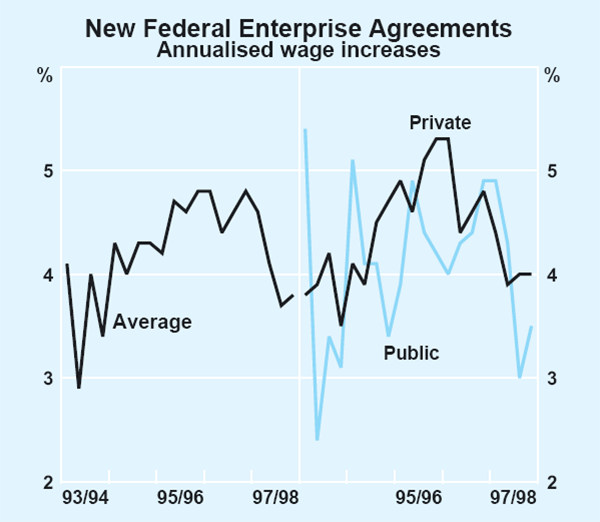
Other indicators of wage costs suggest that wage pressures have eased over the past year (Table 15). The ABS wage cost index increased by 0.4 per cent in the June quarter, and at an annual rate of just under 3 per cent over the three quarters for which data are available. While it is still too early to assess the reliability of this indicator, the data available so far support the impression that the AWOTE measure may have been overstating the overall rate of wage increases. The NAB survey, which reports estimates by businesses of their average increase in labour costs, points to a gradual slowing of wage increases over the past year. Inflation in executive pay may also have moderated, according to the Cullen Egan Dell survey. Executive salaries, which had consistently grown at an annual rate around 6 per cent for several years, increased by 5 per cent over the four quarters to September.
| 1998 | ||||
|---|---|---|---|---|
| March | June | September | Latest two quarters annualised |
|
| Wage cost index (total pay) | ||||
| Private | 1.0 | 0.4 | – | 2.8 |
| Public | 1.0 | 0.4 | – | 2.8 |
| Total | 1.0 | 0.4 | – | 2.8 |
| AWOTE | ||||
| Private | 1.3 | 0.8 | – | 4.2 |
| Public | 1.9 | 0.4 | – | 4.7 |
| Total | 1.4 | 0.6 | 1.7 | 4.6 |
| Enterprise agreements | ||||
| Private | 4.0 | 4.0 | – | – |
| Total | 3.7 | 3.8 | – | – |
The ACTU has announced a new minimum wage claim which is likely to be considered early next year. Increases in minimum wages in the past two years do not appear to have had a large impact on aggregate wage growth but have seen some sizeable increases in real wages of the low-paid. As such, their main economic impact is likely to be on employment of low-skilled workers rather than on aggregate wages and inflation. The current claim is for an increase in the minimum wage of $26.60 a week, to $400, amounting to an increase of 7 per cent for those at the minimum; the $26.60 increase would apply to all minimum award rates of pay up to $527.80 per week, from where a 5 per cent increase would apply. This compares with last year's claim for a $20 increase, which eventually led to increases of between $10 and $14 being awarded.
Inflation expectations
Although inflation has remained subdued during 1998, the prospect of higher retail prices flowing from the exchange rate depreciation has raised consumers' expectations for inflation in the near-term. The Melbourne Institute's survey of consumers' inflation expectations, while very volatile in recent months, shows a clear rise in expectations from historical lows late last year (Graph 35). In October, consumers expected prices to rise by 3.7 per cent during the year ahead, although it is a feature of this survey that expectations are consistently higher than actual inflation. The greater volatility of the survey results in recent months may reflect uncertainty generated by the sharp movements in the exchange rate.
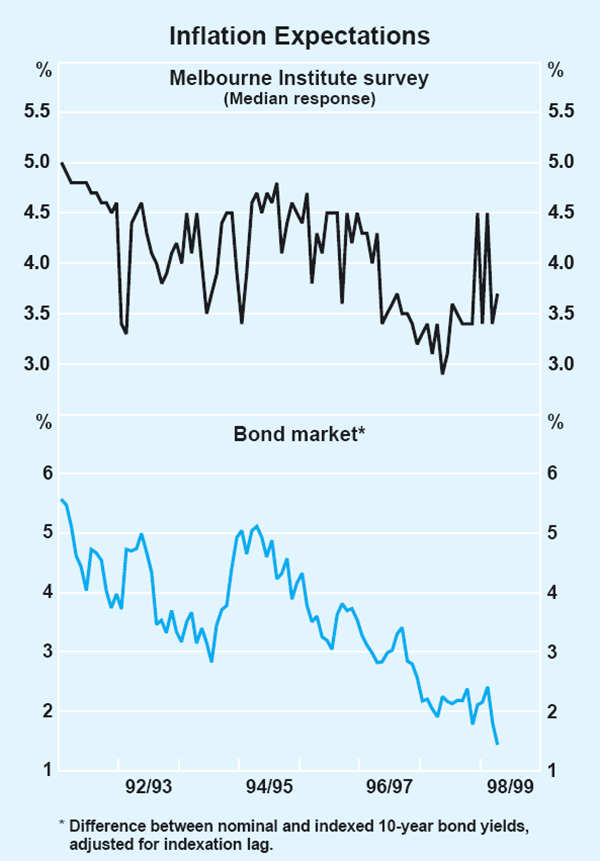
A survey of trade union officials conducted by the Australian Centre for Industrial Relations Research and Training (ACIRRT) after the release of the September quarter CPI, obtained a median forecast of 2.0 per cent inflation over the year to June 1999 and 2.4 per cent over the year to June 2000 (Table 16). This latter projection is significantly lower than in the previous survey taken three months earlier. A similar picture emerged from the Bank's survey of financial market economists, also taken after the CPI release, which gave a median inflation forecast of 2.2 per cent over the year to June 1999 and 2.4 per cent over the year to June 2000. These forecasts, especially for the coming year, are noticeably lower than in the previous survey.
Surveys of the selling price expectations of firms offer no clear consensus on the near-term outlook for inflation. Respondents to the NAB survey of non-farm businesses expect to raise prices by 0.4 per cent in the December quarter, similar to their expectations in recent quarters. The same is true when the retail sector is considered separately. In contrast, the ABS survey shows retail firms expecting to raise prices in December by 0.8 per cent, the highest quarterly rate of increase in three years. Surveys of manufacturers, such as ACCI-Westpac, generally imply a continuance of very moderate price growth.
| Year to Jun 1999 | Year to Jun 2000 | ||
|---|---|---|---|
| Oct 1997 | Oct 1998 | Oct 1998 | |
| Market economists(a) | |||
| Headline | 3.2 | 2.2 | 2.4 |
| Underlying | 2.6 | 2.3 | 2.3 |
| Union officials(b) | |||
| ‘Inflation’ | 2.7 | 2.0 | 2.4 |
|
(a) RBA survey of financial market economists. (b) ACCIRT survey of trade union officials. This survey does not explicitly distinguish between underlying and headline inflation measures. |
|||
While higher import prices may temporarily raise inflation, it is expectations about the medium-term that are likely to be the more important influence on price and wage-setting. In this regard, the NAB survey continues to show an increasing number of businesses – now nearly 40 per cent – who expect inflation to average less than 3 per cent over the medium-term. The longer-term expectations of financial market participants, as implied by the price of indexed bonds, have remained close to 2 per cent during 1998.
Inflation outlook
The exchange rate depreciation since mid 1997 has not yet flowed through into higher consumer prices, but can be expected to have an impact over the next year. Inflation over that period therefore will hinge on the net effect of subdued domestic inflationary pressures and the import price pass-through.
On the basis of historical relationships, and given current exchange rates and rates of wages growth, the rise in wholesale import prices already in evidence would be expected to lift the overall CPI inflation rate to a peak of around 3 per cent during 1999, following which a gradual decline could be anticipated.
Recent data suggest the possibility that the run-up in inflation might be somewhat less than that if unusually competitive conditions were to continue to put a dampener on pass-through at the consumer level as they appear to have done so far. Were the world economic situation to continue to weaken, it is also conceivable that competitive pressures in international markets might contain import prices at their source, though it is hard to find concrete evidence of this in published data at present. If the import price pass-through is simply slower, of course, the short-term peak in inflation would be lower, but also more prolonged.
Beyond the next year, price trends are more likely to be driven by domestic factors. Were inflation expectations to pick up noticeably as a result of the temporary rise in inflation, and be reflected in price and wage decisions, currently low levels of domestic inflation would pick up, sustaining overall inflation at higher rates once the exchange rate effects have been completed. The risk of that outcome appears to be low at present, even though inflation expectations have moved up in some cases. Another risk on the up-side for inflation is the possibility that the exchange rate might again weaken, though as always the impact of this would depend on what other forces were associated with the exchange rate movement.
Overall, the Bank's current assessment is that inflation – in both CPI and underlying terms – will be consistent with the target of 2–3 per cent over the foreseeable future.
Box D: Implications for Monetary Policy of Changes to the CPI[1]
Since 1993, the conduct of monetary policy in Australia has been based on an inflation target. The Statement on the Conduct of Monetary Policy, issued by the Treasurer and the Governor in 1996, formalised the target as ‘keeping underlying inflation between 2 and 3 per cent, on average, over the cycle’. Although no specific measure of underlying inflation was referred to in this statement, it has been customary to evaluate monetary policy in terms of the so-called ‘Treasury underlying’ rate. Other measures of underlying or core inflation can be calculated, but on any measure, it is clear that the inflation target has been achieved in the 1990s (Table D1).
| 1990–98 | 1993–98 | |
|---|---|---|
| Underlying measures(a) | ||
| Treasury underlying CPI | 2.4 | 2.1 |
| Private-sector goods and services | 2.5 | 2.2 |
| Median price change | 2.3 | 2.0 |
| Trimmed mean price change | 2.5 | 2.1 |
| CPI measures | ||
| Consumer price index | 2.1 | 2.0 |
| ‘Acquisitions’ CPI | 2.6 | 2.3 |
| (a) For definitions, see ‘Measuring Underlying Inflation’, Reserve Bank of Australia Bulletin, August 1994. | ||
The concept of underlying inflation has been used to avoid the distortions associated with the most common measure of inflation – the Consumer Price Index (CPI). The main difficulty with using the CPI to evaluate monetary policy has been the inclusion, since 1986, of mortgage interest charges as a measure of the cost of owner-occupied housing. Ideally, for monetary policy purposes, a consumer price index should measure changes in the price of consumer goods and services and not the price of assets or the costs associated with financing their acquisition. Moreover, the inclusion of interest rates meant that the CPI would move perversely following a change in the monetary policy instrument: a rise in interest rates aimed at reducing medium-term inflation pressures would push the measured CPI up in the short term.
Recently, the Australian Bureau of Statistics implemented changes to the calculation of the CPI which will significantly reduce the problems in using the published CPI to evaluate monetary policy. Beginning with the September quarter release, the CPI is now being constructed using an ‘acquisitions’ approach to measuring prices, rather than the ‘outlays’ approach used previously. As a consequence, the cost of housing services for owner occupiers will now be measured by the cost of acquiring a new dwelling (excluding land) rather than the outlays involved in servicing the mortgage which financed the purchase.
The behaviour of the new CPI is not known with certainty, but a reasonable guide from recent history can be obtained by substituting an index of prices of new dwellings for interest charges in the existing CPI. This is the series labelled ‘acquisitions’ CPI in Graph D1. This shows that the ‘acquisitions’ measure is much less volatile than the CPI, demonstrating that much of the observed volatility in the CPI was induced by the inclusion of interest rates.
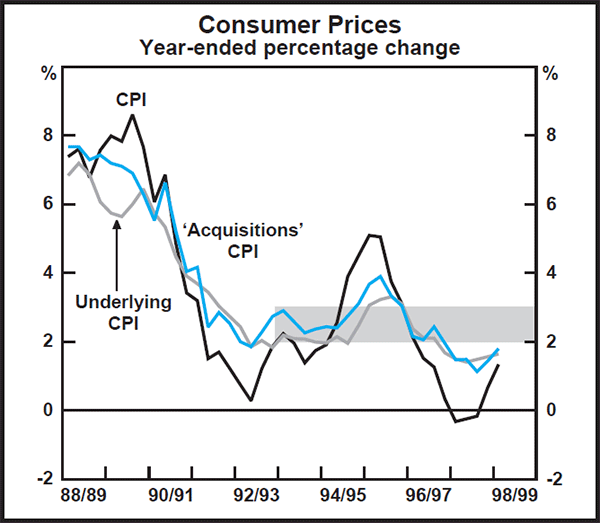
Since 1990, the average rates of inflation as measured by these series were each between 2 and 3 per cent (Table D1). Over this particular period, the ‘acquisitions’ CPI recorded a slightly higher rate of inflation, on average, than the underlying series – by a few tenths of a percentage point per year. This is because prices for certain items excluded from the underlying series (in particular, tobacco and health) have recorded higher rates of increase than the average over the period. Overall, however, the trends are not markedly different and it seems unlikely that the conduct of monetary policy would have been different had the target been specified in terms of an acquisitions-based CPI rather than underlying inflation.
On the assumption that the ‘acquisitions’ CPI above is a reasonable guide to the behaviour of the new CPI, and given the wider community recognition of the CPI, the Bank's judgment is that the inflation target – maintaining inflation of 2–3 per cent on average over time – can now be understood as referring to the published CPI. The CPI will still be affected from time to time by temporary factors which do not signify persistent trends in inflation, but given the average nature of the target such fluctuations should not make for too many problems for policy. Of course, the Bank will continue to analyse underlying inflation measures, as these can be informative about the influence of such temporary factors on the CPI.
The Treasurer has agreed that this approach is consistent with the intent of the Statement on the Conduct of Monetary Policy of August 1996.
Footnote Box D
For a more detailed discussion of these issues, see ‘The Implications of Recent Changes to the Consumer Price Index for Monetary Policy and the Inflation Target’, Reserve Bank of Australia Bulletin, October 1998, pp. 1–5. [1]